Sub-Saharan Africa
Sub-Saharan Africa | |
|---|---|
 Geographical map of sub-Saharan Africa The Sahara The Sahel Sub-Saharan Africa
| |
| Major cities | Abidjan,Abuja,Accra,Addis Ababa,Cape Town,Dar es Salaam,Durban,Harare,Johannesburg,Juba,Kampala,Kinshasa,Lagos,Luanda,Lusaka,Mogadishu,Nairobi,Pretoria,Windhoek,Dodoma,Maputo,Jinja |
| Population (2021)[a] | 1,137,938,708 |
| Demonyms | African |
| Religions (2020) | |
| •Christianity | 62.0% |
| •Islam | 31.4% |
| •Traditional faiths | 3.2% |
| •No religion | 3.0% |
| • Other | 0.4% |
| Languages | Over 1,000 languages |
| InternetTLD | .africa |
| |
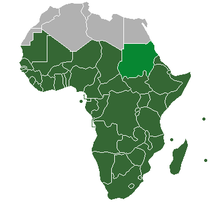
Lighter green:TheSudan,classified as a part ofNorth Africaby theUnited Nations Statistics Division[2]instead ofEastern Africa,though the organization states that "the assignment of countries or areas to specific groupings is for statistical convenience and does not imply any assumption regarding political or other affiliation of countries or territories."
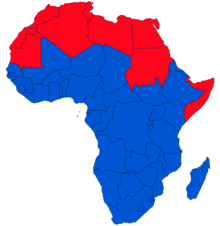

Sub-Saharan Africa,Subsahara,orNon-Mediterranean Africa[3]is the area and regions of the continent ofAfricathat lie south of theSahara.These includeCentral Africa,East Africa,Southern Africa,andWest Africa.Geopolitically, in addition to theAfrican countries and territoriesthat are situated fully in that specified region, the term may also include polities that only have part of their territory located in that region, per the definition of theUnited Nations(UN).[4]This is considered a non-standardized geographical region with the number of countries included varying from 46 to 48 depending on the organization describing the region (e.g.UN,WHO,World Bank,etc.). TheAfrican Union(AU) uses a different regional breakdown, recognizing all 55 member states on the continent—grouping them into five distinct and standard regions.
The term serves as a grouping counterpart toNorth Africa,which is instead grouped with the definition ofMENA(i.e.Middle Eastand North Africa) as it is part of theArab world,and most North African states are likewise members of theArab League.However, while they are alsomember states of the Arab League,theComoros,Djibouti,Mauritania,andSomalia(and sometimesSudan) are all geographically considered to be part of sub-Saharan Africa.[5]Overall, theUN Development Programmeapplies the "sub-Saharan" classification to 46 of Africa's 55 countries, excluding Djibouti,SADR,Somalia, and Sudan.[6]
Since around3900 BCE,[7][8]the Saharan and sub-Saharan regions of Africa have been separated by the extremely harsh climate of the sparsely populated Sahara, forming an effective barrier that is interrupted only by theNilein Sudan, though navigation on the Nile was blocked by theSuddandthe river's cataracts.There is alsoan evident genetic dividebetween North Africa and sub-Saharan Africa that dates back to theNeolithic.TheSahara pump theoryexplains howfloraandfauna(includingHomo sapiens) left Africa to penetrateEurasiaand beyond. Africanpluvialperiods are associated with a "Wet Sahara"phase, during which larger lakes and more rivers existed.[9]
Nomenclature
[edit]
Geographers historically divided the region into several distinctethnographicsections based on each area's respective inhabitants.[10]
Commentators in Arabic in themedieval periodused the general termbilâd as-sûdân( "Land of the Blacks" ) for the vastSudan region(an expression denotingCentralandWest Africa),[11]or sometimes extending from the coast of West Africa toWestern Sudan.[12]Its equivalent inSoutheast AfricawasZanj( "Country of the Blacks" ), which was situated in the vicinity of theGreat Lakesregion.[10][12]
The geographers drew an explicit ethnographic distinction between the Sudan region and its analogue Zanj, from the area to their extreme east on theRed Seacoast in theHorn of Africa.[10]In modern-day Ethiopia andEritreawasAl-Habashor Abyssinia,[13]which was inhabited by theHabashor Abyssinians, who were the forebears of theHabesha.[14]In northern Somalia wasBarbaraor theBilad al-Barbar( "Land of theBerbers"), which was inhabited by the EasternBaribahorBarbaroi,as the ancestors of theSomaliswere referred to by medieval Arab and ancientGreekgeographers, respectively.[10][15][16][17]
In the 19th and 20th centuries, the populations south of the Sahara were divided into three broad ancestral groups:HamitesandSemitesin the Horn of Africa and Sahel related to those in North Africa, who spoke languages belonging to theAfroasiaticfamily;Negroesin most of the rest of the subcontinent (hence, the toponymBlack Africafor Africa south of the Sahara[18]), who spoke languages belonging to theNiger-CongoandNilo-Saharanfamilies; andKhoisaninSouthern Africa,who spoke languages belonging to theKhoisanfamily.
Climate zones and ecoregions
[edit]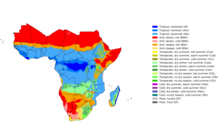
Sub-Saharan Africa has a wide variety ofclimate zonesorbiomes.South Africaand theDemocratic Republic of the Congoin particular are consideredmegadiverse countries.It has a dry winter season and a wet summer season.
- TheSahelextends across all of Africa at a latitude of about 10° to 15° N. Countries that include parts of the Sahara Desert proper in their northern territories and parts of the Sahel in their southern region includeMauritania,Mali,Niger,Chad,andSudan.The Sahel has ahot semi-arid climate.
- South of the Sahel, a belt ofsavanna(theWestandEast Sudanian savannas) stretch from the Atlantic Ocean to theEthiopian Highlands.The more humidGuineanandNorthern Congolian forest–savanna mosaiclie between the savannas and the equatorial forests.
- TheHorn of Africaincludeshot desert climatealong the coast but ahot semi-arid climatecan be found much more in the interior, contrasting with savanna andmoist broadleaf forestsin theEthiopian Highlands.
- Tropical Africaencompassestropical rainforeststretching along the southern coast of West Africa and across most of Central Africa (theCongo) west of theAfrican Great Lakes.
- In East Africa, woodlands, savannas, and grasslands are found in the equatorial zone, including theSerengetiecosystem in Tanzania and Kenya.
- DistinctiveAfromontaneforests, grasslands, and shrublands are found in the high mountains and mountain ranges of eastern Africa, from the Ethiopian Highlands to South Africa.
- South of the equatorial forests, theWesternandSouthern Congolian forest–savanna mosaicare transition zones between the tropical forests and themiombo woodlandbelt that spans the continent fromAngolatoMozambiqueandTanzania.
- TheNamibandKalahari Desertslie in Southern Africa, and are surrounded by semi-deserts including theKarooregion of South Africa. TheBushveldgrasslands lie to the east of the deserts.
- TheCape Floristic Regionis at Africa's southern tip, and is home to diverse subtropical and temperate forests, woodlands, grasslands, and shrublands.
History
[edit]Prehistory
[edit]
According topaleontology,early hominid skull anatomy was similar to that of their close cousins, the great African forestapes,gorillaandchimpanzee.However, they had adopted abipedallocomotion and freed hands, giving them a crucial advantage enabling them to live in both forested areas and on the opensavannaat a time when Africa was drying up, with savanna encroaching on forested areas. This occurred 10 million to 5 million years ago.[19]
By 3 million years ago severalaustralopithecinehominidspecies had developed throughoutSouthern,East,andCentral Africa.They were tool users rather than tool manufacturers. The next major evolutionary step occurred around 2.3 million BCE, when primitivestone toolswere used to scavenge the carcasses of animals killed by other predators, both for their meat and their marrow. In hunting,H. habiliswas most likely not capable of competing with large predators and was more prey than hunter, althoughH. habilislikely did steal eggs from nests and may have been able to catch smallgameand weakened larger prey such as cubs and older animals. The tools were classed asOldowan.[20]
Roughly 1.8 million years ago,Homo ergasterfirst appeared in the fossil record in Africa. FromHomo ergaster,Homo erectus(upright man) evolved 1.5 million years ago. Some of the earlier representatives of this species were small-brained and used primitivestone tools,much likeH. habilis.The brain later grew in size, andH. erectuseventually developed a more complex stone tool technology called theAcheulean.Potentially the first hominid to engage in hunting,H. erectusmastered the art of making fire. They were the first hominids to leave Africa, going on to colonize the entireOld World,and perhaps later on giving rise toHomo floresiensis.Although some recent writers suggest thatH. georgicus,aH. habilisdescendant,was the first and most primitive hominid to ever live outside Africa, many scientists considerH. georgicusto be an early and primitive member of theH. erectusspecies.[21]
The fossil and genetic evidence showsHomo sapiensdeveloped in Southern and East Africa by around 350,000 to 260,000 years ago[22][23][24]and gradually migrated across the continent in waves. Between 50,000 and 60,000 years ago, their expansionout of Africalaunched the colonization of the planet by modern humans. By 10,000 BCE,Homo sapienshad spread to all corners of the world. This dispersal of the human species is suggested by linguistic, cultural and genetic evidence.[20][25]
During the 11th millenniumBP,pottery was independently invented in West Africa, with the earliest pottery there dating to about 9,400 BC from central Mali.[26]It spread throughout theSaheland southernSahara.[27]
After the Sahara became a desert, it did not present a totally impenetrable barrier for travelers between north and south because of the application of animal husbandry towards carrying water, food, and supplies across the desert. Prior to the introduction of thecamel,[28]the use of oxen, mule, and horses for desert crossing was common, and trade routes followed chains ofoasesthat were strung across the desert. Thetrans-saharan tradewas in full motion by 500 BCE withCarthagebeing a major economic force for its establishment.[29][30][31]It is thought that the camel was first brought toEgyptafter thePersian Empireconquered Egypt in 525 BCE, although large herds did not become common enough in North Africa for camels to be the pack animal of choice for the trans-saharan trade.[32]
West Africa
[edit]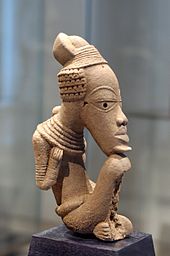
TheBantu expansionis a major migration movement that originated in West Central Africa (possibly around Cameroon) around 2500 BCE, reaching East and Central Africa by 1000 BCE and Southern Africa by the early centuries CE.
TheDjenné-Djennocity-state flourished from 250 BCE to 900 CE and was influential to the development of theGhana Empire.TheNok cultureof Nigeria (lasting from 1,500 BCE to 200 CE) is known from a type ofterracottafigure.[33]There were a number of medieval empires of the southern Sahara and the Sahel, based ontrans-Saharan trade,including theGhana Empireand theMali Empire,Songhai Empire,theKanem Empireand the subsequentBornu Empire.[34]They built stone structures like inTichit,but mainly constructed inadobe.TheGreat Mosque of Djenneis most reflective of Sahelian architecture and is the largest adobe building in the world.
In the forest zone, several states and empires such asBono State,Akwamuand others emerged. TheAshanti Empirearose in the 18th century in modern-dayGhana.[35]TheKingdom of Nri,was established by theIgboin the 11th century. Nri was famous for having a priest-king who wielded no military power. Nri was a rare African state which was a haven for freed slaves and outcasts who sought refuge in their territory. Other major states included the kingdoms ofIfẹandOyoin the western block of Nigeria which became prominent about 700–900 and 1400 respectively, and center ofYorubaculture. The Yoruba's built massive mud walls around their cities, the most famous beingSungbo's Eredo.Another prominent kingdom in southwestern Nigeria was theKingdom of Benin9th–11th century whose power lasted between the 15th and 19th century and was one of the greatest Empires of African history documented all over the world. Their dominance reached as far as the well-known city of Eko which was namedLagosby the Portuguese traders and other early European settlers. TheEdo-speaking people of Benin are known for their famous bronze casting and rich coral, wealth, ancient science and technology and theWalls of Benin,which is the largest man-made structure in the world.
In the 18th century, the Oyo and theAro confederacywere responsible for most of the slaves exported from modern-day Nigeria, selling them toEuropean slave traders.[36]Following theNapoleonic Wars,the British expanded their influence into the Nigerian interior. In 1885, British claims to a West African sphere of influence received international recognition, and in the following year theRoyal Niger Companywas chartered under the leadership ofSir George Goldie.In 1900, the company's territory came under the control of the British government, which moved to consolidate its hold over the area of modern Nigeria. On 1 January 1901, NigeriabecameaBritish protectorateas part of theBritish Empire,the foremost world power at the time. Nigeria was granted itsindependencein 1960 during the period ofdecolonization.
Central Africa
[edit]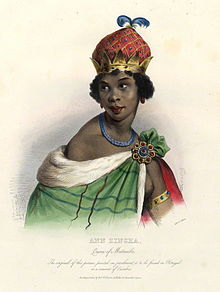
Archeological finds in Central Africa provide evidence of human settlement that may date back over 10,000 years.[37]According to Zangato and Holl, there is evidence of iron-smelting in the Central African Republic and Cameroon that may date back to 3,000 to 2,500 BCE.[38]Extensive walled sites and settlements have recently been found inZilum,Chad. The area is located approximately 60 km (37 mi) southwest of Lake Chad, and has beenradiocarbon datedto the first millennium BCE.[39][40]
Trade and improved agricultural techniques supported more sophisticated societies, leading to the early civilizations ofSao,Kanem,Bornu,Shilluk,Baguirmi,andWadai.[41]
Following theBantu Migrationinto Central Africa, during the 14th century, theLuba Kingdomin southeast Congo came about under a king whose political authority derived from religious, spiritual legitimacy. The kingdom controlled agriculture and regional trade of salt and iron from the north and copper from the Zambian/Congo copper belt.[42]
Rival kingship factions which split from the Luba Kingdom later moved among the Lunda people, marrying into its elite and laying the foundation of theLunda Empirein the 16th century. The ruling dynasty centralised authority among the Lunda under the Mwata Yamyo or Mwaant Yaav. The Mwata Yamyo's legitimacy, like that of the Luba king, came from being viewed as a spiritual religious guardian. Thisimperial cultor system of divine kings was spread to most of central Africa by rivals in kingship migrating and forming new states. Many new states received legitimacy by claiming descent from the Lunda dynasties.[42]
TheKingdom of Kongoexisted from the Atlantic west to the Kwango river to the east. During the 15th century, the Bakongo farming community was united with its capital atM'banza-Kongo,under the king title,Manikongo.[42]Other significant states and peoples included theKuba Kingdom,producers of the famous raffia cloth, theEastern Lunda,Bemba,Burundi,Rwanda,and theKingdom of Ndongo.
East Africa
[edit]Sudan
[edit]
Nubia,covered by present-day northernSudanand southernEgypt,was referred to as "Aethiopia"(" land of the burnt face ") by theGreeks.[43]Nubia in her greatest phase is considered sub-Saharan Africa's oldest urban civilisation. Nubia was a major source of gold for the ancient world. Nubians built famous structures and numerous pyramids. Sudan, the site of ancient Nubia, has more pyramids than anywhere else in the world.[44][better source needed]
Horn of Africa
[edit]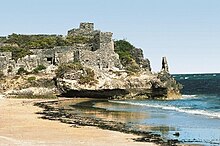
TheAxumite Empirespanned the southern Sahara, south Arabia and the Sahel along the western shore of theRed Sea.Located in northernEthiopiaandEritrea,Aksum was deeply involved in the trade network between India and the Mediterranean. Growing from the proto-AksumiteIron Ageperiod (c.4th century BCE), it rose to prominence by the 1st century CE. The Aksumites constructed monolithicstelaeto cover the graves of their kings, such asKing Ezana's Stele.The laterZagwe dynasty,established in the 12th century, built churches out of solid rock. These rock-hewn structures include theChurch of St. George at Lalibela.

Inancient Somalia,city-states flourished such asOpone,MosyllonandMalaothat competed with theSabaeans,ParthiansandAxumitesfor the wealthyIndo–Greco–Romantrade.[45]
In the Middle Ages several powerful Somali empires dominated the region's trade, including theAjuran Sultanate,which excelled inhydraulicengineeringand fortress building,[46]theSultanate of Adal,whose GeneralAhmed Gureywas the first African commander in history to use cannon warfare on the continent duringAdal's conquestof theEthiopian Empire,[47]and theGeledi Sultanate,whose military dominance forced governors of theOmani empirenorth of the city ofLamuto pay tribute to theSomaliSultanAhmed Yusuf.[48][49][50]
Southeast Africa
[edit]According to the theory ofrecent African origin of modern humans,the mainstream position held within the scientific community, all humans originate from either Southeast Africa or the Horn of Africa.[51]During the first millennium CE,NiloticandBantu-speaking peoplesmoved into the region,and the latter now account for three-quarters of Kenya's population.

On the coastal section of Southeast Africa, a mixed Bantu community developed through contact withMuslimArabandPersiantraders, leading to the development of the mixed Arab, Persian and AfricanSwahili City States.[52]TheSwahili culturethat emerged from these exchanges evinces many Arab and Islamic influences not seen in traditional Bantu culture, as do the manyAfro-Arabmembers of the BantuSwahili people.With its original speech community centered on the coastal parts ofTanzania(particularlyZanzibar) andKenya– a seaboard referred to as theSwahili Coast– the BantuSwahili languagecontains manyArabicloan-wordsas a consequence of these interactions.[53]
The earliest Bantu inhabitants of the Southeast coast of Kenya and Tanzania encountered by these later Arab and Persian settlers have been variously identified with the trading settlements ofRhapta,AzaniaandMenouthias[54]referenced in early Greek and Chinese writings from 50 CE to 500 CE.[55][56][57][58][59][60][61][62]These early writings perhaps document the first wave of Bantu settlers to reach Southeast Africa during their migration.[63]
Between the 14th and 15th centuries, large medieval Southeast African kingdoms and states emerged, such as theBuganda,[64]BunyoroandKaragwe[64]kingdoms of Uganda and Tanzania.
During the early 1960s, the Southeast African nations achieved independence from colonial rule.
Southern Africa
[edit]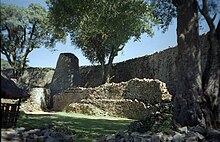
Settlements ofBantu-speaking peoples, who wereiron-using agriculturists and herdsmen, were already present south of theLimpopo Riverby the 4th or 5th century displacing and absorbing the originalKhoisanspeakers. They slowly moved south, and the earliest ironworks in modern-dayKwaZulu-Natal Provinceare believed to date from around 1050. The southernmost group was theXhosa people,whose language incorporates certain linguistic traits from the earlier Khoisan inhabitants. They reached theFish Riverin today'sEastern Cape Province.Monomotapawas a medieval kingdom (c. 1250–1629), which existed between theZambeziandLimpoporivers ofSouthern Africain the territory of modern-dayZimbabweandMozambique.Its old capital was located atGreat Zimbabwe.
In 1487,Bartolomeu Diasbecame the first European to reach the southernmost tip of Africa. In 1652, avictualling stationwas established at theCape of Good HopebyJan van Riebeeckon behalf of theDutch East India Company.For most of the 17th and 18th centuries, the slowly expanding settlement was aDutchpossession. In 1795, the Dutch colony was captured by theBritishduring theFrench Revolutionary Wars.The British intended to useCape Townas a major port on the route toAustraliaandIndia.It was later returned to the Dutch in 1803, but soon afterward the Dutch East India Company declared bankruptcy, and the Dutch (now under French control) and the British found themselves at war again. The British captured the Dutch possession yet again at theBattle of Blaauwberg,commanded bySir David Blair.TheZulu Kingdomwas a Southern African tribal state in what is nowKwaZulu-Natalin southeastern South Africa. The small kingdom gained world fame during and after their defeat in theAnglo-Zulu War.During the 1950s and early 1960s, most sub-Saharan African nations achieved independence from colonial rule.[65]
Demographics
[edit]Population
[edit]

According to the 2022 revision of the World Population Prospects[66][67],the population of sub-Saharan Africa was 1.1 billion in 2019. The current growth rate is 2.3%. The UN predicts for the region a population between 2 and 2.5 billion by 2050[68]with a population density of 80 per km2compared to 170 for Western Europe, 140 for Asia and 30 for the Americas.
Sub-Saharan African countries top thelist of countries and territories by fertility ratewith 40 of the highest 50, all withTFRgreater than 4 in 2008. All are above the world average exceptSouth AfricaandSeychelles.[69]More than 40% of the population in sub-Saharan countries isyoungerthan 15 years old, as well as inSudan,with the exception of South Africa.[70]
| Country | Population | Area (km2) | Literacy (M/F)[71] | GDP per Capita (PPP)[72] | Trans (Rank/Score)[73] | Life (Exp.)[71] | HDI | EODBR/SAB[74] | PFI(RANK/MARK) |
|---|---|---|---|---|---|---|---|---|---|
| 18,498,000 | 1,246,700 | 82.9%/54.2% | 6,800 | 168/2 | 42.4 | 0.486 | 172/171 | 132/58,43 | |
| 8,988,091 | 27,830 | 67.3%/52.2% | 700 | 168/1.8 | 49 | 0.316 | 176/130 | 103/29,00 | |
| 68,692,542 | 2,345,410 | 80.9%/54.1% | 800 | 162/11.9 | 46.1 | 0.286 | 182/152 | 146/53,50 | |
| 18,879,301 | 475,440 | 77%/59.8% | 3,700 | 146/2.2 | 50.3 | 0.482 | 171/174 | 109/30,50 | |
| 4,511,488 | 622,984 | 64.8%/33.5% | 700 | 158/2.8 | 44.4 | 0.343 | 183/159 | 80/17,75 | |
| 10,329,208 | 1,284,000 | 40.8%/12.8% | 2,300 | 175/1.6 | 50.6 | 0.328 | 178/182 | 132/44,50 | |
| 3,700,000 | 342,000 | 90.5%/79.0% | 800 | 162/1.9 | 54.8 | 0.533 | N/A | 116/34,25 | |
| 1,110,000 | 28,051 | 93.4%/80.3% | 37,400 | 168/1.8 | 51.1 | 0.537 | 170/178 | 158/65,50 | |
| 1,514,993 | 267,667 | 88.5%/79.7% | 18,100 | 106/2.9 | 56.7 | 0.674 | 158/152 | 129/43,50 | |
| 39,002,772 | 582,650 | 77.7%/70.2% | 3,500 | 146/2.2 | 57.8 | 0.519 | 95/124 | 96/25,00 | |
| 174,507,539 | 923,768 | 84.4%/72.7%[75] | 5,900 | 136/2.7 | 57 | 0.504 | 131/120 | 112/34,24 | |
| 10,473,282 | 26,338 | 71.4%/59.8% | 2,100 | 89/3.3 | 46.8 | 0.429 | 67/11 | 157/64,67 | |
| 212,679 | 1,001 | 92.2%/77.9% | 3,200 | 111/2.8 | 65.2 | 0.509 | 180/140 | NA | |
| 44,928,923 | 945,087 | 77.5%/62.2% | 3,200 | 126/2.6 | 51.9 | 0.466 | 131/120 | NA/15,50 | |
| 32,369,558 | 236,040 | 76.8%/57.7% | 2,400 | 130/2.5 | 50.7 | 0.446 | 112/129 | 86/21,50 | |
| 31,894,000 | 1,886,068 | 79.6%/60.8% | 4,300 | 176/1.5 | 62.57[76] | 0.408 | 154/118 | 148/54,00 | |
| 8,260,490 | 619,745 | 1,600 | |||||||
| 516,055 | 23,000 | N/A | 3,600 | 111/2.8 | 54.5 | 0.430 | 163/177 | 110/31,00 | |
| 5,647,168 | 121,320 | N/A | 1,600 | 126/2.6 | 57.3 | 0.349 | 175/181 | 175/115,50 | |
| 85,237,338 | 1,127,127 | 50%/28.8% | 2,200 | 120/2.7 | 52.5 | 0.363 | 107/93 | 140/49,00 | |
| 9,832,017 | 637,657 | N/A | N/A | 180/1.1 | 47.7 | N/A | N/A | 164/77,50 | |
| 1,990,876 | 600,370 | 80.4%/81.8% | 17,000 | 37/5.6 | 49.8 | 0.633 | 45/83 | 62/15,50 | |
| 752,438 | 2,170 | N/A | 1,600 | 143/2.3 | 63.2 | 0.433 | 162/168 | 82/19,00 | |
| 2,130,819 | 30,355 | 73.7%/90.3% | 3,300 | 89/3.3 | 42.9 | 0.450 | 130/131 | 99/27,50 | |
| 19,625,000 | 587,041 | 76.5%/65.3% | 1,600 | 99/3.0 | 59 | 0.480 | 134/12 | 134/45,83 | |
| 14,268,711 | 118,480 | N/A | 1,200 | 89/3.3 | 47.6 | 0.400 | 132/128 | 62/15,50 | |
| 1,284,264 | 2,040 | 88.2%/80.5% | 22,300 | 42/5.4 | 73.2 | 0.728 | 17/10 | 51/14,00 | |
| 21,669,278 | 801,590 | N/A | 1,300 | 130/2.5 | 42.5 | 0.322 | 135/96 | 82/19,00 | |
| 2,108,665 | 825,418 | 86.8%/83.6% | 11,200 | 56/4.5 | 52.5 | 0.625 | 66/123 | 35/9,00 | |
| 87,476 | 455 | 91.4%/92.3% | 29,300 | 54/4.8 | 72.2 | 0.773 | 111/81 | 72/16,00 | |
| 59,899,991 | 1,219,912 | N/A | 13,600 | 55/4.7 | 50.7 | 0.619 | 34/67 | 33/8,50 | |
| 1,123,913 | 17,363 | 80.9%/78.3% | 11,089 | 79/3.6 | 40.8 | 0.608 | 115/158 | 144/52,50 | |
| 11,862,740 | 752,614 | N/A | 4,000 | 99/3.0 | 41.7 | 0.430 | 90/94 | 97/26,75 | |
| 11,392,629 | 390,580 | 92.7%/86.2% | 2,300 | 146/2.2 | 42.7 | 0.376 | 159/155 | 136/46,50 | |
| 8,791,832 | 112,620 | 47.9%/42.3% | 2,300 | 106/2.9 | 56.2 | 0.427 | 172/155 | 97/26,75 | |
| 12,666,987 | 1,240,000 | 32.7%/15.9% | 2,200 | 111/2.8 | 53.8 | 0.359 | 156/139 | 38/8,00 | |
| 15,730,977 | 274,200 | 25.3% | 1,900 | 79/3.6 | 51 | 0.331 | 150/116 | N/A | |
| 499,000 | 322,462 | 7,000 | |||||||
| 20,617,068 | 322,463 | 3,900 | |||||||
| 1,782,893 | 11,295 | 2,600 | |||||||
| 24,200,000 | 238,535 | 4,700 | |||||||
| 10,057,975 | 245,857 | 2,200 | |||||||
| 1,647,000 | 36,125 | 1,900 | |||||||
| 4,128,572 | 111,369 | 1,300 | |||||||
| 3,359,185 | 1,030,700 | 4,500 | |||||||
| 17,129,076 | 1,267,000 | 1,200 | |||||||
| 12,855,153 | 196,712 | 3,500 | |||||||
| 6,190,280 | 71,740 | 1,600 | |||||||
| 7,154,237 | 56,785 | 1,700 |
GDP per Capita (PPP)(2016, 2017 (PPP, US$)),Life (Exp.)(Life Expectancy 2006),Literacy (Male/Female 2006),Trans(Transparency 2009),HDI(Human Development Index),EODBR(Ease of Doing Business Rank June 2008 through May 2009),SAB(Starting a Business June 2008 through May 2009),PFI(Press Freedom Index 2009)
Languages and ethnic groups
[edit]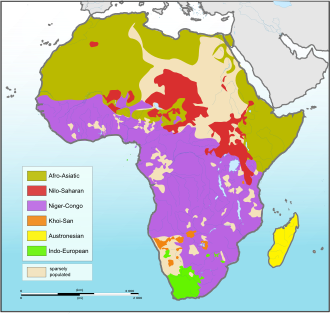
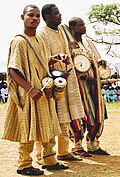
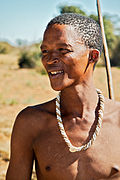



Sub-Saharan Africa contains over 1,500 languages.
Afroasiatic
[edit]With the exception of the extinctSumerian(alanguage isolate) ofMesopotamia,Afroasiatic has the oldest documented history of any language family in the world. Egyptian was recorded as early as 3200 BCE. TheSemiticbranch was recorded as early as 2900 BCE in the form of theAkkadian languageof Mesopotamia (AssyriaandBabylonia) and circa 2500 BCE in the form of theEblaite languageof northeasternSyria.[77]
The distribution of theAfroasiatic languageswithin Africa is principally concentrated in North Africa and the Horn of Africa. Languages belonging to the family'sBerberbranch are mainly spoken in the north, with its speech area extending into the Sahel (northern Mauritania, northern Mali, northern Niger).[78][79]TheCushiticbranch of Afroasiatic is centered in the Horn, and is also spoken in the Nile Valley and parts of the African Great Lakes region. Additionally, the Semitic branch of the family, in the form ofArabic,is widely spoken in the parts of Africa that are within the Arab world.South Semitic languagesare also spoken in parts of the Horn of Africa (Ethiopia, Eritrea). TheChadicbranch is distributed in Central and West Africa.[80]Hausa,its most widely spoken language, serves as alingua francain West Africa (Niger, Ghana, Togo, Benin, Cameroon, and Chad).[81]
Khoisan
[edit]The several families lumped under the termKhoi-Saninclude languages indigenous toSouthern AfricaandTanzania,though some, such as theKhoi languages,appear to have moved to their current locations not long before theBantu expansion.[82]In Southern Africa, their speakers are theKhoikhoiandSan(Bushmen), in Southeast Africa, theSandaweandHadza.
Niger–Congo
[edit]TheNiger–Congofamily is the largest in the world in terms of the number of languages (1,436) it contains.[83]The vast majority of languages of this family aretonal,such asYorubaandIgbo.However, others such asFulani,WolofandKiswahiliare not. A major branch of the Niger–Congo languages isBantu,which covers a greater geographic area than the rest of the family. Bantu speakers represent the majority of inhabitants in southern, central and southeastern Africa, thoughSan,Pygmy,andNiloticgroups, respectively, can also be found in those regions. Bantu-speakers can also be found in parts ofCentral Africasuch as theGabon,Equatorial Guineaand southernCameroon.Swahili,a Bantu language with manyArabic,Persianand other Middle Eastern and South Asianloan words,developed as alingua francafor trade between the different peoples in southeastern Africa. In theKalahari Desertof Southern Africa, the distinct people known as Bushmen (also "San", closely related to, but distinct from "Hottentots") have long been present. The San evince unique physical traits, and are the indigenous people of southern Africa. Pygmies are the pre-Bantu indigenous peoples of Central Africa.
Nilo-Saharan
[edit]TheNilo-Saharan languagesare concentrated in the upper parts of theChariandNilerivers of Central Africa and Southeast Africa. They are principally spoken byNiloticpeoples and are also spoken in Sudan among theFur,Masalit,NubianandZaghawapeoples and in West and Central Africa among theSonghai,ZarmaandKanuri.TheOld Nubian languageis also a member of this family.
Major languages of Africa by region, family and number ofprimary languagespeakers in millions:
|
|
|
|
|
Genetic history
[edit]Major cities
[edit]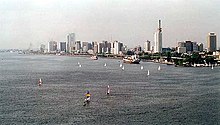
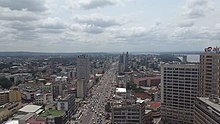
Sub-Saharan Africa has several large cities.Lagosis a city in theNigerianstateofLagos.The city, with its adjoiningconurbation,isthe most populous in Nigeria,and the second-most populous inAfricaafterCairo,Egypt.It is one of the fastest-growing cities in the world,[118][119][120][121][122][123][124]and also one of the most populousurban agglomerations.[125][126]Lagos is a majorfinancial centrein Africa; thismegacityhas the highest GDP,[127]and also housesApapa,one of the largest and busiest ports on the continent.[128][129][130]
Dar es Salaamis the former capital of, as well as the most populous city in,Tanzania;it is a regionally important economic centre.[131]It is located on theSwahili coast.
Johannesburgis the largest city inSouth Africa.It is theprovincialcapital and largest city inGauteng,which is the wealthiest province in South Africa.[132]While Johannesburg is not one ofSouth Africa's three capital cities,it is the seat of theConstitutional Court.The city is located in the mineral-richWitwatersrandrange of hills, and is the centre of a large-scale gold and diamond trade.
Nairobiis the capital and the largest city ofKenya.The name comes from theMaasaiphraseEnkare Nyrobi,which translates to "cool water", a reference to theNairobi Riverwhich flows through the city. The city is popularly referred to as the Green City in the Sun.[133]
Other major cities in sub-Saharan Africa includeAbidjan,Cape Town,Kinshasa,Luanda,MogadishuandAddis Ababa.
Largest cities or towns in Sub Saharan Africa
worldpopulationreview 2022 City Population estimates. | |||||||||
|---|---|---|---|---|---|---|---|---|---|
| Rank | Pop. | Rank | Pop. | ||||||
| 1 | Lagos | 21,320,000 | 11 | Yaounde | 4,336,670 | ||||
| 2 | Kinshasa | 17,071,000 | 12 | Kano | 4,219,209 | ||||
| 3 | Johannesburg | 11,061,878 | 13 | Douala | 3,926,645 | ||||
| 4 | Luanda | 8,952,496 | 14 | Ibadan | 3,756,445 | ||||
| 5 | Dar es Salaam | 7,404,689 | 15 | Antananarivo | 3,669,900 | ||||
| 6 | Khartoum | 6,160,327 | 16 | Abuja | 3,652,029 | ||||
| 7 | Abidjan | 5,515,794 | 17 | Kampala | 3,651,919 | ||||
| 8 | Addis Ababa | 5,227,794 | 18 | Kumasi | 3,630,326 | ||||
| 9 | Nairobi | 5,118,844 | 19 | Dakar | 3,326,001 | ||||
| 10 | Cape Town | 4,800,954 | 20 | Port Harcourt | 3,324,694 | ||||
Economy
[edit]This section needs to beupdated.The reason given is: The most recent data in this section seems to be from 2015.(April 2021) |
In the mid-2010s, private capital flew to sub-Saharan Africa – primarily from theBRICs,private-sector investment portfolios, and remittances – began to exceed official development assistance.[134]

As of 2011, Africa is one of the fastest developing regions in the world. Six of the world's ten fastest-growing economies over the previous decade were situated below the Sahara, with the remaining four in East and Central Asia. According to theWorld Bank,the economic growth rate in the region had risen to 4.7% in 2013. This continued rise was attributed to increasing investment in infrastructure and resources as well as steady expenditure per household.[135]
In 2019, 424 million people in sub-Saharan Africa were reportedly living in severe poverty. In 2022, 460 million people—an increase of 36 million in only three years—were anticipated to be living in extreme poverty as a result of theCOVID-19 pandemicand theRussian invasion of Ukraine.[136][137][138]Sub-Saharan Africa'sgovernment debtrose from 28% ofgross domestic productin 2012 to 50% of gross domestic product in 2019. The COVID-19 pandemic caused it to rise to 57% ofgross domestic productin 2021.[139][140][141]
Sub-Saharan Africa was severely harmed when government revenue declined from 22% of GDP in 2011 to 17% in 2021. 15 African nations were (or are) at significant risk of debt, and 7 were (2021) in financial crisis according to the IMF.[142][143][144] The region went on to receive IMFSpecial Drawing Rightsof $23 billion in 2021 to assist critical public spending.[145]
Energy and power
[edit]| Rank | Area | bb/day | Year | Like... |
|---|---|---|---|---|
| _ | W: World | 85,540,000 | 2007 est. | |
| 01 | E: Russia | 9,980,000 | 2007 est. | |
| 02 | Ar: Saudi Arb | 9,200,000 | 2008 est. | |
| 04 | As: Libya | 4,725,000 | 2008 est. | Iran |
| 10 | Af: Nigeria | 2,352,000 | 2011 est. | Norway |
| 15 | Af: Algeria | 2,173,000 | 2007 est. | |
| 16 | Af: Angola | 1,910,000 | 2008 est. | |
| 17 | Af: Egypt | 1,845,000 | 2007 est. | |
| 27 | Af: Tunisia | 664,000 | 2007 est. | Australia |
| 31 | Af: Sudan | 466,100 | 2007 est. | Ecuador |
| 33 | Af: Eq.Guinea | 368,500 | 2007 est. | Vietnam |
| 38 | Af: DR Congo | 261,000 | 2008 est. | |
| 39 | Af: Gabon | 243,900 | 2007 est. | |
| 40 | Af: Sth Africa | 199,100 | 2007 est. | |
| 45 | Af: Chad | 156,000 | 2008 est. | Germany |
| 53 | Af: Cameroon | 87,400 | 2008 est. | France |
| 56 | E: France | 71,400 | 2007 | |
| 60 | Af: Ivory Coast | 54,400 | 2008 est. | |
| _ | Af: Africa | 10,780,400 | 2011 | Russia |
| Source:CIA.govArchived12 May 2012 at theWayback Machine,World Facts Book > Oil exporters. | ||||

As of 2009[update],50% of Africa was rural with no access to electricity. In 2021, Africa generated 889 TWh of electricity, amounting to 3.13% of the global market share.[146]Many countries were (as of 2009) affected by power shortages.[147]
The percentage of residences with access to electricity in sub-Saharan Africa is the lowest in the world. In some remote regions, fewer than one in every 20 households has electricity.[148][149][150]

Because of rising prices in commodities such as coal and oil, thermal sources of energy are proving to be too expensive for power generation. Sub-Saharan Africa has the potential to generate 1,750 TWh of energy, of which only 7% has been explored. The failure to exploit its full energy potential is largely due to significant underinvestment, as at least four times as much (approximately $23 billion a year) and what is currently spent is invested in operating high cost power systems and not on expanding the infrastructure.[151]
African governments are taking advantage of the readily available water resources to broaden their energy mix. Hydro Turbine Markets in sub-Saharan Africa generated revenues of $120.0 million in 2007 and was estimated to reach $425.0 million.[when?] Asian countries, notably China, India, and Japan, are playing an active role in power projects across the African continent. The majority of these power projects are hydro-based because of China's vast experience in the construction of hydro-power projects and part of the Energy & Power Growth Partnership Services programme.[152]
With electrification numbers, sub-Saharan Africa with access to the Sahara and being in the tropical zones has massive potential for solarphotovoltaicelectrical potential.[153]Six hundred million people could be served with electricity based on its photovoltaic potential.[154][failed verification] In 2003, China promised to train 10,000 technicians from Africa and other developing countries in the use of solar energy technologies over the next five years. Training African technicians to use solar power is part of the China-Africa science and technology cooperation agreement signed by Chinese science ministerXu Guanhuaand African counterparts during premier Wen Jiabao's visit to Ethiopia in December 2003.[155]
TheNew Partnership for Africa's Development(NEPAD) is developing an integrated, continent-wide energy strategy. This has been funded by, amongst others, theAfrican Development Bank(AfDB) and the EU-Africa Infrastructure Trust Fund. These projects must be sustainable, involve a cross-border dimension and/or have a regional impact, involve public and private capital, contribute to poverty alleviation and economic development, and involve at least one country in sub-Saharan Africa.[151]
Renewable Energy Performance Platform was established by theEuropean Investment Bankand theUnited Nations Environment Programmewith a five-year goal of improving energy access for at least two million people in sub-Saharan Africa. It has so far invested around $45 million to renewable energy projects in 13 countries in sub-Saharan Africa.Solar powerandhydropowerare among the energy methods used in the projects.[148][156]
Media
[edit]In 2007, Radio was the major source of information in sub-Saharan Africa.[157]Average coverage stands at more than a third of the population. Countries such asGabon,Seychelles,andSouth Africaboast almost 100% penetration. Only five countries—Burundi,Djibouti,Eritrea,Ethiopia,andSomalia—still have a penetration of less than 10%.Broadband penetrationoutside of South Africa has been limited where it is exorbitantly expensive.[158][159]Access to the internet via cell phones is on the rise.[160]
Television is the second major source of information.[157]Because of power shortages, the spread of television viewing has been limited. Eight per cent have television, a total of 62 million. Those in the television industry view the region as an untapped green market. Digital television and pay for service are on the rise.[161]
Oil and minerals
[edit]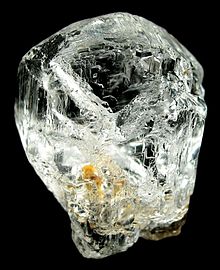
The region is a major exporter to the world ofgold,uranium,chromium,vanadium,antimony,coltan,bauxite,iron ore,copper,andmanganese.South Africa, along withGabonandGhana,collectively supplies over 60% of globalmanganese,and is also a major exporter ofchromium.[162][163]A 2001 estimate is that 42% of the world's reserves of chromium may be found in South Africa.[164]South Africa is the largest producer ofplatinum,with 80% of the total world's annual mine production and 88% of the world's platinum reserve.[165]Sub-Saharan Africa produces 33% of the world's bauxite, with Guinea as the major supplier.[166]Zambia is a major producer of copper.[167]The Democratic Republic of Congo is a major source of coltan. Production from DR Congo is very small, but the country has 80% of the proven reserves in Africa, which are 80% of those worldwide.[168]Sub-Saharan Africa is a major producer of gold, producing up to 30% of global production. Major suppliers are South Africa, Ghana, Zimbabwe, Tanzania, Guinea, and Mali. South Africa had been first in the world in terms of gold production since 1905, but in 2007 it moved to second place, according to GFMS, the precious metals consultancy.[169]Uranium is major commodity from the region. Significant suppliers are Niger, Namibia, and South Africa. Namibia was the number one supplier from sub-Saharan Africa in 2008.[170]The region produces 49% of the world'sdiamonds.
Sub-Saharan Africa has been the focus of an intense race for oil by the West, China, India, and other emerging economies, even though it holds only 10% of proven oil reserves, less than the Middle East. This race has been referred to as the secondScramble for Africa.All reasons for this global scramble come from the reserves' economic benefits. Transportation cost is low and no pipelines have to be laid as in Central Asia. Almost all reserves are offshore, so political turmoil within the host country will not directly interfere with operations. Sub-Saharan oil is viscous, with a very low sulfur content. This quickens the refining process and effectively reduces costs. New sources of oil are being located in sub-Saharan Africa more frequently than anywhere else. Of all new sources of oil,1⁄3are in sub-Saharan Africa.[171]
Sub-Saharan Africa is a key player in the globalmineralsmarket, producing over 70%of the world'scobaltand hosting about 50%of its reserves in theDemocratic Republic of Congo(DRC). The region also harbors significantlithiumdeposits inZimbabwe,the DRC, andMali.[163]
Agriculture
[edit]
Sub-Saharan Africa has more variety of grains than anywhere in the world. Between 13,000 and 11,000 BCE wild grains began to be collected as a source of food in the cataract region of the Nile, south of Egypt. The collecting of wild grains as source of food spread to Syria, parts of Turkey, and Iran by the eleventh millennium BCE. By the tenth and ninth millennia southwest Asians domesticated their wild grains, wheat, and barley after the notion of collecting wild grains spread from the Nile.[172]
Numerous crops have been domesticated in the region and spread to other parts of the world. These crops includedsorghum,castor beans,coffee,cotton,[173]okra,black-eyed peas,watermelon,gourd,and pearlmillet.Other domesticated crops includedteff,enset,African rice,yams,kola nuts,oil palm,andraffia palm.[172][174]
Domesticated animals include theguinea fowland thedonkey.

Agriculture represents 20% to 30% of GDP and 50% of exports. In some cases, 60% to 90% of the labor force are employed in agriculture.[175]Most agricultural activity is subsistence farming. This has made agricultural activityvulnerable to climate changeand global warming. As of right now Sub-Saharan Africa has degraded land covering one million square kilometres.[176]Biotechnology has been advocated to create high yield, pest and environmentally resistant crops in the hands of small farmers. TheBill and Melinda Gates Foundationis a strong advocate and donor to this cause. Biotechnology and GM crops have met resistance both by natives and environmental groups.
Cash crops include cotton, coffee, tea, cocoa, sugar, and tobacco.[177]
TheOECDsays Africa has the potential to become an agricultural superbloc if it can unlock the wealth of the savannahs by allowing farmers to use their land as collateral for credit.[178]There is such international interest in sub-Saharan agriculture, that the World Bank increased its financing of African agricultural programs to $1.3 billion in the 2011 fiscal year.[179]Recently, there has been a trend to purchase large tracts of land in sub-Sahara for agricultural use by developing countries.[180][181] Early in 2009,George Soroshighlighted a new farmland buying frenzy caused by growing population, scarce water supplies and climate change. Chinese interests bought up large swathes of Senegal to supply it with sesame. Aggressive moves by China, South Korea, and Gulf states to buy vast tracts of agricultural land in sub-Saharan Africa could soon be limited by a new global international protocol.[182]
Infrastructure
[edit]
According to researchers at theOverseas Development Institute,the lack of infrastructure in manydeveloping countriesrepresents one of the most significant limitations toeconomic growthand achievement of theMillennium Development Goals(MDGs).[151][180][181]Infrastructure investments and maintenance can be very expensive, especially in such as areas as landlocked, rural and sparsely populated countries in Africa.[151]
Infrastructure investments contributed to Africa's growth, and increased investment is necessary to maintain growth and tackle poverty.[151][180][181]The returns to investment in infrastructure are very significant, with on average 30–40% returns fortelecommunications(ICT) investments, over 40% forelectricitygeneration and 80% for roads.[151]
In Africa, it is argued that in order to meet the MDGs, infrastructure investments would need to reach about 15% of GDP (around $93 billion a year).[151]Currently, the source of financing varies significantly across sectors.[151]Some sectors are dominated by state spending, others by overseasdevelopment aid(ODA) and yet others by private investors.[151]In sub-Saharan Africa, the state spends around $9.4 billion out of a total of $24.9 billion.[151]Inirrigation,SSA states represent almost all spending; in transport and energy a majority of investment is state spending; inICTandwater supplyandsanitation,the private sector represents the majority of capital expenditure.[151]Overall, aid, the private sector and non-OECD financiers between them exceed state spending.[151]The private sector spending alone equals state capital expenditure, though the majority is focused on ICT infrastructure investments.[151]External financing increased from $7 billion (2002) to $27 billion (2009). China, in particular, has emerged as an important investor.[151]
Transport
[edit]
Less than 40% of rural Africans live within two kilometers of an all-season road, the lowest level of rural accessibility in the developing world. Spending on roads averages just below 2% of GDP with varying degree among countries. This compares with 1% of GDP that is typical in industrialised countries, and 2–3% of GDP found in fast-growing emerging economies. Although the level of expenditure is high relative to the size of Africa's economies, it remains small in absolute terms, with low-income countries spending an average of about US$7 per capita per year.[183]
Education
[edit]
Forty per cent of African scientists live inOECDcountries, predominantly in Europe, the United States and Canada.[184]This has been described as an Africanbrain drain.[185][186]According toNaledi Pandor,the South African Minister of Science and Technology, even with the drain enrollments in sub-Saharan African universities tripled between 1991 and 2005, expanding at an annual rate of 8.7%, which is one of the highest regional growth rates in the world.[citation needed]In the last 10 to 15 years interest in pursuing university-level degrees abroad has increased.[184]
According to the CIA, low global literacy rates are concentrated in sub-Saharan Africa,West AsiaandSouth Asia.However, literacy rates in sub-Saharan Africa vary significantly between countries. The highest registered literacy rate in the region is inZimbabwe(90.7%; 2003 est.), while the lowest literacy rate is inSouth Sudan(27%).[187]
Research onhuman capitalformation was able to determine, that thenumeracylevels of sub-Saharan Africa and Africa, in general, were higher than numeracy levels in South Asia. In the 1940s more than 75% of the population of sub-Saharan Africa was numerate. The numeracy of the West African countries, Benin and Ghana, was even higher with more than 80% of the population being numerate. In contrast, numeracy in South Asia was only around 50%.[188]
Higher diversity in Sub-Saharan African countries has been found to lead to a poorer economy. Researchers have argued that this is because of ethnic favoritism in their politics. Sub-Saharan leaders are more likely to provide better resources to their coethnic groups when in power. A study found that, on average, children of the favored ethnic group are 2.25% more likely to attend primary school and 1.80% more likely to complete primary school. A 1% increase in GDP is associated with a 1.5% increase in the ethnic favoritism effect on primary school attendance.[189]
Sub-Saharan African countries spent an average of 0.3% of their GDP on science and technology in 2007. This represents an increase from US$1.8 billion in 2002 to US$2.8 billion in 2007, a 50% increase in spending.[190][191]
Major progress in access to education
[edit]
At the World Conference held inJomtien,Thailandin 1990, delegates from 155 countries and representatives of some 150 organizations gathered with the goal to promoteuniversal primary educationand the radical reduction of illiteracy before the end of the decade. TheWorld Education Forum,held ten years later inDakar,Senegal,provided the opportunity to reiterate and reinforce these goals. This initiative contributed to having education made a priority of theMillennium Development Goalsin 2000, with the aim of achieving universal schooling (MDG2) and eliminating gender disparities, especially in primary and secondary education (MDG3).[192]Since the World Education Forum in Dakar, considerable efforts have been made to respond to these demographic challenges in terms of education. The amount of funds raised has been decisive. Between 1999 and 2010, public spending on education as a percentage ofgross national product (GNP)increased by 5% per year in sub-Saharan Africa, with major variations between countries, with percentages varying from 1.8% in Cameroon to over 6% in Burundi.[193]As of 2015, governments in sub-Saharan Africa spend on average 18% of their total budget on education, against 15% in the rest of the world.[192]
In the years immediately after the Dakar Forum, the efforts made by the African States towards achievingEFAproduced multiple results in sub-Saharan Africa. The greatest advance was in access to primary education, which governments had made their absolute priority. The number of children in a primary school in sub-Saharan Africa thus rose from 82 million in 1999 to 136.4 million in 2011. In Niger, for example, the number of children entering school increased by more than three-and-a-half times between 1999 and 2011.[193]In Ethiopia, over the same period, over 8.5 million more children were admitted to primary school. The net rate of first-year access in sub-Saharan Africa has thus risen by 19 points in 12 years, from 58% in 1999 to 77% in 2011. Despite the considerable efforts, the latest available data from theUNESCO Institute for Statisticsestimates that, for 2012, there were still 57.8 million children who were not in school. Of these, 29.6 million were in sub-Saharan Africa alone, a figure which has not changed for several years.[192]Many sub-Saharan countries have notably included the first year of secondary school in basic education. In Rwanda, the first year of secondary school was attached to primary education in 2009, which significantly increased the number of pupils enrolled at this level of education.[193][192]In 2012, the primary completion rate (PCR) – which measures the proportion of children reaching the final year of primary school – was 70%, meaning that more than three out of ten children entering primary school do not reach the final primary year.[192]
Literacy rates have gone up in sub-Saharan Africa, and internet access has improved considerably. At least 39 countries in sub-Saharan Africa have some large-scale school feeding programs, which can improve access to education. In aggregate, 16% of school-age children (and 25% of primary school-age children) in the region benefit from school meal programs, and about 82% of the funding for these programs is provided by governments.[194]Nonetheless, a lot must yet happen for this region to catch up. The statistics show that the literacy rate for sub-Saharan Africa was 65% in 2017. In other words, one-third of the people aged 15 and above were unable to read and write. The comparative figure for 1984 was an illiteracy rate of 49%. In 2017, only about 22% of Africans were internet users at all, according to the International Telecommunication Union (ITU).[195]
Science and technology
[edit]Health
[edit]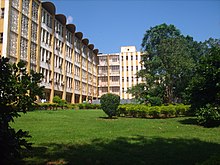
Health challenges in Sub-Saharan Africa includeHIV/AIDS in Africa,malaria,neglected tropical diseases,tuberculosis,onchocerciasis,maternal mortalityandinfant mortality.[196][197][198][199][200]
In 1987, theBamako Initiativeconference organized by theWorld Health Organizationwas held inBamako,the capital ofMali,and helped reshape the health policy of sub-Saharan Africa.[201]The new strategy dramatically increased accessibility through community-basedhealthcare reform,resulting in more efficient and equitable provision of services.[202][self-published source?]A comprehensive approach strategy was extended to all areas of health care, with subsequent improvement in the health care indicators and improvement in health care efficiency and cost.[203][204]

In 2011, sub-Saharan Africa was home to 69% of all people living withHIV/AIDSworldwide.[205]In response, a number of initiatives have been launched to educate the public on HIV/AIDS. Among these are combination prevention programmes, considered to be the most effective initiative, theabstinence, be faithful, use a condomcampaign, and theDesmond Tutu HIV Foundation's outreach programs.[206]According to a 2013 special report issued by theJoint United Nations Programme on HIV/AIDS(UNAIDS), the number of HIV positive people in Africa receiving anti-retro viral treatment in 2012 was over seven times the number receiving treatment in 2005, with an almost 1 million added in the last year alone.[207][208]: 15 The number of AIDS-related deaths in sub-Saharan Africa in 2011 was 33 per cent less than the number in 2005.[209]The number of new HIV infections in sub-Saharan Africa in 2011 was 25 per cent less than the number in 2001.[209]
Life expectancy at birthin sub-Saharan Africa increased from 40 years in 1960 to 61 years in 2017.[210]
Malariais an endemic illness in sub-Saharan Africa, where the majority of malaria cases and deaths worldwide occur.[211]Routine immunization has been introduced in order to preventmeasles.[212]Onchocerciasis( "river blindness" ), a common cause ofblindness,is also endemic to parts of the region. More than 99% of people affected by the illness worldwide live in 31 countries therein.[213]In response, the African Programme for Onchocerciasis Control (APOC) was launched in 1995 with the aim of controlling the disease.[213]Maternal mortalityis another challenge, with more than half of maternal deaths in the world occurring in sub-Saharan Africa.[214]However, there has generally been progress here as well, as a number of countries in the region have halved their levels of maternal mortality since 1990.[214]Additionally, theAfrican Unionin July 2003 ratified theMaputo Protocol,which pledges to prohibitfemale genital mutilation(FGM).[215][216]Somalia, Guinea, Djibouti, Sierra Leone and Mali have the highest prevalence of FGM in the world.[217]Infibulation,the most extreme form of FGM, is concentrated primarily inNortheast Africa.[218]
National health systems vary between countries. InGhana,most health care is provided by the government and largely administered by theMinistry of HealthandGhana Health Services.The healthcare system has five levels of providers: health posts which are first-level primary care for rural areas, health centers and clinics, district hospitals, regional hospitals, and tertiary hospitals. These programs are funded by the government of Ghana, financial credits, Internally Generated Fund (IGF), and Donors-pooled Health Fund.[219]
Ebola virus disease,which was first identified in 1976, occasionally occurs in outbreaks in tropical regions of Sub-Saharan Africa.[220]The 2013–2016Western African Ebola virus epidemicoriginated in Guinea, later speading to neighboring Liberia and Sierra Leone.[221]
Religion
[edit]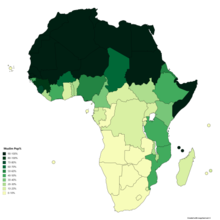
African countries below the Sahara are largelyChristian,while those above the Sahara, inNorth Africa,are predominantlyIslamic.There are also Muslim majorities in parts of the Horn of Africa (DjiboutiandSomalia) and in the Sahel and Sudan regions (the Gambia,Sierra Leone,Guinea,Mali,Niger,SenegalandBurkina Faso), as well as significant Muslim communities inEthiopiaandEritrea,and on the Swahili Coast (Tanzania,MozambiqueandKenya).[222][223]West Africa is the only subregion of sub-Saharan Africa which has a Muslim majority population, andNigeriahas the largest Muslim population in sub-Saharan Africa.[223]
Mauritiusis the only country inAfricato have aHindumajority. In 2012, sub-Saharan Africa constituted in absolute terms theworld's third largest Christian population,after Europe andLatin Americarespectively.[224]In 2012, sub-Saharan Africa also constituted in absolute terms theworld's third largest Muslim population,afterAsiaand theMiddle East and North Africarespectively.[225]
Traditional African religionsare also commonly practiced across sub-Saharan Africa, with these religions being especially common inSouth Sudan,[226]Guinea Bissau,[227]Mozambique,[228]andCameroon.[229]Traditional African religions can be broken down into linguistic cultural groups, with common themes. AmongNiger–Congo-speakers is a belief in a creator god or higher deity, along with ancestor spirits, territorial spirits, evil caused by human ill will and neglecting ancestor spirits, and priests of territorial spirits.[230][231][232][233]New world religions such asSantería,Vodun,andCandomblé,would be derived from this world. AmongNilo-Saharanspeakers is the belief in Divinity; evil is caused by divine judgement and retribution; prophets as middlemen between Divinity and man. AmongAfro-Asiatic-speakers ishenotheism,the belief in one's own gods but accepting the existence of other gods; evil here is caused by malevolent spirits. The SemiticAbrahamic religionofJudaismis comparable to the latter world view.[234][230][235]San religionis non-theistic but a belief in a Spirit or Power of existence which can be tapped in a trance-dance; trance-healers.[236]
Generally, traditional African religions are united by an ancient complexanimismandancestor worship.[237]
Traditional religions in sub-Saharan Africa often display complex ontology, cosmology and metaphysics. Mythologies, for example, demonstrated the difficulty fathers of creation had in bringing about order from chaos. Order is what is right and natural and any deviation is chaos.Cosmologyandontologyis also neither simple or linear. It defines duality, the material and immaterial, male and female, heaven and earth. Common principles of being and becoming are widespread: Among the Dogon, the principle ofAmma(being) andNummo(becoming), and among the Bambara,Pemba(being) andFaro(becoming).[238]

- West Africa
- Akan mythology
- Ashanti mythology(Ghana)
- Dahomey (Fon) mythology
- Efik mythology(Nigeria, Cameroon)
- Igbo mythology(Nigeria)
- Serer religionandSerer creation myth(Senegal, Gambia and Mauritania)
- Yoruba mythology(Nigeria, Benin)
- Central Africa
- Dinka mythology(South Sudan)
- Lotuko mythology(South Sudan)
- Bushongo mythology(Congo)
- Bambuti (Pygmy) mythology(Congo)
- Lugbara mythology(Congo)
- Southeast Africa
- Akamba mythology(eastern Kenya)
- Masai mythology(Kenya, Tanzania)
- Southern Africa
- Khoisan religion
- Lozi mythology(Zambia)
- Tumbuka mythology(Malawi)
- Zulu mythology(South Africa)
Sub-Saharan traditional divination systems display great sophistication. For example, the bamana sand divination uses well established symbolic codes that can be reproduced using four bits or marks. A binary system of one or two marks are combined. Random outcomes are generated using afractalrecursive process. It is analogous to a digital circuit but can be reproduced on any surface with one or two marks. This system is widespread in sub-Saharan Africa.[239][page needed]
Culture
[edit]Sub-Saharan Africa is diverse, with many communities, villages, and cities, each with their own beliefs and traditions. Traditional African Societies are communal, they believe that the needs of the many far outweigh an individual's needs and achievements. Essentially, an individual's keep must be shared with other extended family members. Extended families are made up of various individuals and families who have shared responsibilities within the community. This extended family is one of the core aspects of every African community. "An African will refer to an older person as auntie or uncle. Siblings of parents will be called father or mother rather than uncle and aunt. Cousins will be called brother or sister". This system can be very difficult for outsiders to understand; however, it is no less important. "Also reflecting their communal ethic, Africans are reluctant to stand out in a crowd or to appear different from their neighbors or colleagues, a result of social pressure to avoid offense to group standards and traditions." Women also have a very important role in African culture because they take care of the house and children. Traditionally, in many cultures "men do the heavy work of clearing and ploughing the land, women sow the seeds, tend the fields, harvest the crops, haul the water, and bear the major burden for growing the family's food". Despite their work in the fields, women are expected to be subservient to men in some African cultures. "When young women migrate to cities, this imbalance between the sexes, as well as financial need, often causes young women of lower economic status, who lack education and job training, to have sexual relationships with older men who are established in their work or profession and can afford to support a girlfriend or two".[240]
Art
[edit]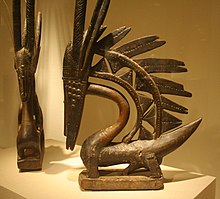
The oldestabstract artin the world is a shell necklace, dated to 82,000 years, in the Cave of Pigeons inTaforalt,eastern Morocco.[241]The second-oldest abstract form of art, and the oldest rock art, is found in theBlombos Caveat the Cape in South Africa, dated 77,000 years.[242]Sub-Saharan Africa has some of the oldest and most varied style of rock art in the world.[243]
Although sub-Saharan African art is very diverse, there are some common themes. One is the use of the human figure. Second, there is a preference forsculpture.Sub-Saharan African art is meant to be experienced in three dimensions, not two. A house is meant to be experienced from all angles. Third, art is meant to be performed. Sub-Saharan Africans have a specific name for masks. The name incorporates the sculpture, the dance, and the spirit that incorporates the mask. The name denotes all three elements. Fourth, art that serves a practical function. The artist and craftsman are not separate. A sculpture shaped like a hand can be used as a stool. Fifth, the use offractalsor non-linear scaling. The shape of the whole is the shape of the parts at different scales. Before the discovery of fractal geometry, Leopold Sedar Senghor, Senegal's first president, referred to this as "dynamic symmetry".William Fagg,a British art historian, has compared it to the logarithmic mapping of natural growth by biologist D'Arcy Thompson. Lastly, sub-Saharan African art is visually abstract, instead of naturalistic. Sub-Saharan African art represents spiritual notions, social norms, ideas, values, etc. An artist might exaggerate the head of a sculpture in relation to the body not because he does not know anatomy but because he wants to illustrate that the head is the seat of knowledge and wisdom.
The visual abstraction of African art was very influential in the works ofmodernist artistslikePablo Picasso,Henri Matisse,andJacques Lipchitz.[244][245]
Architecture
[edit]Music
[edit]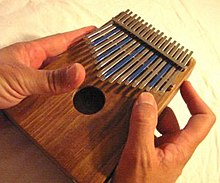
Traditional sub-Saharan African music is as diverse as the region's various populations. The common perception of sub-Saharan African music is that it is rhythmic music centered around the drums. This is partially true. A large part of sub-Saharan music, mainly among speakers ofNiger–CongoandNilo-Saharanlanguages, is rhythmic and centered around the drum. Sub-Saharan music is polyrhythmic, usually consisting of multiple rhythms in one composition. Dance involves moving multiple body parts. These aspects of sub-Saharan music has been transferred to the new world by enslaved sub-Saharan Africans and can be seen in its influence on music forms assamba,jazz,rhythm and blues,rock and roll,salsa,reggaeandrap music.[246]
Some forms of sub-Saharan African music use strings, horns, and very little poly-rhythms. Music from the eastern Sahel and along the Nile, among theNilo-Saharan,made extensive use of strings and horns in ancient times. Among theAfro-AsiaticsofNortheast Africa,there is extensive use ofstring instrumentsand thepentatonic scale.Dancing involves swaying body movements and footwork. Among theSanis extensive use of string instruments with emphasis on footwork.[247]
Modern sub-Saharan African music has been influenced by music from the New World (Jazz, Salsa, Rhythm and Blues etc.) vice versa being influenced by enslaved sub-Saharan Africans. Popular styles areMbalaxinSenegalandGambia,HighlifeinGhana,ZoblazoinIvory Coast,MakossainCameroon,Soukousin theDemocratic Republic of Congo,KizombainAngola,andMbaqangainSouth Africa.New World styles like Salsa, R&B/Rap, Reggae, and Zouk also have widespread popularity.
Cuisine
[edit]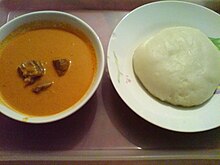
Sub-Saharan African cuisineis very diverse. A lot of regional overlapping occurs, but there are dominant elements region by region.[248]
West African cuisine can be described as starchy, flavorfully spicey. Dishes includefufu,kenkey,couscous,garri,foutou, andbanku.Ingredients are of native starchy tubers,yams,cocoyams,andcassava.Grains includemillet,sorghum,andrice,usually in the Sahel. Oils includepalm oilandshea butter(Sahel). One finds recipes that mixfishandmeat.Beverages arepalm wine(sweet or sour) andmillet beer.Roasting,baking,boiling,frying,mashing,andspicingare all cooking techniques.

Southeast African cuisine, especially those of the Swahili people, reflects its Islamic, geographical Indian Ocean cultural links. Dishes includeugali,sukuma wiki,andhalva.Spices such ascurry,saffron,cloves,cinnamon,pomegranate juice,cardamon,ghee,andsageare used, especially among Muslims. Meat includescattle,sheep,andgoats,but is rarely eaten since meat is viewed as a luxury.
In theHorn of Africa,pork and non-fish seafood are avoided by Christians and Muslims. Dairy products and all meats are avoided during lent by Ethiopians.Maize(corn) is a major staple.Cornmealis used to make ugali, a popular dish with different names.Teffis used to makeinjeraor canjeero (Somali) bread. Other important foods includeenset,noog,lentils,rice,banana,leafy greens,chili peppers,coconut milk,andtomatoes.Beverages are coffee (domesticated in Ethiopia),chai tea,fermentedbeerfrom banana or millet. Cooking techniques include roasting andmarinating.
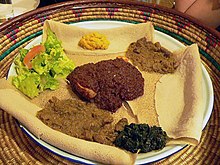
Central African cuisine connects with all major regions of sub-Saharan Africa: Its cuisine reflects that.Ugaliand fufu are eaten in the region. Central African cuisine is very starchy and spicy hot. Dominant crops includeplantains,cassava,peanuts,chillis, and okra. Meats includebeef,chicken,and sometimes exotic meats calledbushmeat(antelope,warthog,crocodile). Widespread spicy hot fish cuisine is one of the differentiating aspects.Mushroomis sometimes used as a meat substitute.
Traditional Southern African cuisine surrounds meat. Traditional society typically focused on raising sheep, goats, and especially cattle. Dishes includebraai(barbecue meat),sadza,bogobe,pap(fermented cornmeal),milk products(buttermilk,yoghurt). Crops utilised are sorghum, maize (corn), pumpkin beans, leafy greens, andcabbage.Beverages include ting (fermented sorghum or maize),milk,chibuku(milky beer). Influences from the Indian and Malay communities can be seen in its use of curries,sambals,pickled fish,fish stews,chutney,andsamosa.European influences can be seen in cuisines likebiltong(dried beef strips),potjies(stews of maize,onions,tomatoes),French wines,and crueler orkoeksister(sugar syrup cookie).
Clothing
[edit]
Like most of the world, sub-Saharan Africans have adopted Western-style clothing. In some countries like Zambia, used Western clothing has flooded markets, causing great angst in the retail community. Sub-Saharan Africa boasts its own traditionalclothing style.Cotton seems to be the dominant material.
In East Africa, one finds extensive use of cotton clothing. Shemma, shama, andkutaare types of Ethiopian clothing.KangaareSwahilicloth that comes in rectangular shapes, made of pure cotton, and put together to make clothing.Kitengesare similar to kangas andkikoy,but are of a thicker cloth, and have an edging only on a long side.Kenya,Uganda,Tanzania,andSouth Sudanare some of the African countries where kitenge is worn. InMalawi,NamibiaandZambia,kitenge is known as Chitenge. One of the unique materials, which is not a fiber and is used to make clothing is barkcloth,[249]an innovation of the Baganda people of Uganda. It came from the Mutuba tree (Ficus natalensis).[250]In Madagascar a type of draped cloth calledlambais worn.

In West Africa, again cotton is the material of choice. In the Sahel and other parts of West Africa theboubouandkaftanstyle of clothing are featured.Kente clothis created by theAkan peopleof Ghana and Ivory Coast, from silk of the various moth species in West Africa. Kente comes from theAkantwiwordkentenwhich means basket. It is sometimes used to makedashikiandkufi.Adire is a type of Yoruba cloth that is starch resistant. Raffia cloth[251]and barkcloth are also utilised in the region.
In Central Africa, the Kuba people developed raffia cloth[251]from the raffia plant fibers. It was widely used in the region. Barkcloth was also extensively used.
In Southern Africa one finds numerous uses of animal hide and skins for clothing. The Ndau in central Mozambique and the Shona mix hide with barkcloth and cotton cloth. Cotton cloth is referred to as machira. Xhosa, Tswana, Sotho, and Swazi also made extensive use of hides. Hides come from cattle, sheep, goat, and elephant. Leopard skins were coveted and were a symbol of kingship in Zulu society. Skins were tanned to form leather, dyed, and embedded with beads.
Theater
[edit]Film industry
[edit]Games
[edit]Sports
[edit]Football (soccer) is the most popular sport in sub-Saharan Africa. Sub-Saharan men are its main patrons. Major competitions include theAfrican Champions League,a competition for the best clubs on the continent and theConfederation Cup,a competition primarily for the national cup winner of each African country. TheAfrica Cup of Nationsis a competition of 16 national teams from various African countries held every two years. South Africa hosted the2010 FIFA World Cup,a first for a sub-Saharan country. In 2010, Cameroon played in theWorld Cupfor the sixth time, which is the current record for a sub-Saharan team. In1996 Nigeria won the Olympic gold for football.In 2000 Cameroon maintained the continent's supremacy by winning the title too. Momentous achievements for sub-Saharan African football. Famous sub-Saharan football stars includeAbedi Pele,Emmanuel Adebayor,George Weah,Michael Essien,Didier Drogba,Roger Milla,Nwankwo Kanu,Jay-Jay Okocha,Bruce Grobbelaar,Samuel Eto'o,Kolo Touré,Yaya Touré,Sadio ManéandPierre-Emerick Aubameyang.The most talented sub-Saharan African football players find themselves courted and sought after by European leagues. There are currently more than 1000 Africans playing for European clubs. Sub-Saharan Africans have found themselves the target of racism by European fans. FIFA has been trying hard to crack down on racist outburst during games.[252][253][254]

Rugbyis popular in sub-Saharan Africa. TheConfederation of African Rugbygoverns rugby games in the region. South Africa is a major force in the game and won the Rugby World Cup in1995,2007and2019.Africa is also allotted one guaranteed qualifying place in theRugby World Cup.
Bo xing is a popular sport.Battling Sikiis the first world champion to come out of sub-Saharan Africa. Countries such as Nigeria, Ghana and South Africa have produced numerous professional world champions such asDick Tiger,Hogan Bassey,Gerrie Coetzee,Samuel Peter,Azumah NelsonandJake Matlala.
Cricket has a following. TheAfrican Cricket Associationis an international body which oversees cricket in African countries. South Africa and Zimbabwe have their own governing bodies. In 2003 theCricket World Cupwas held in South Africa, first time it was held in sub-Saharan Africa.
Over the years,EthiopiaandKenyahave produced many notable long-distance athletes. Each country has federations that identify and cultivate top talent. Athletes from Ethiopia and Kenya hold, save for two exceptions, all the men's outdoor records for Olympic distance events from 800m to themarathon.[255]Famous runners includeHaile Gebrselassie,Kenenisa Bekele,Paul Tergat,andJohn Cheruiyot Korir.[256]
Tourism
[edit]The development oftourismin this region has been identified as having the ability to create jobs and improve the economy. South Africa, Namibia, Mauritius, Botswana, Ghana, Cape Verde, Tanzania and Kenya have been identified as having well developed tourism industries.[257]Cape Townand the surrounding area is very popular with tourists.[258]
List of countries and regional organisation
[edit]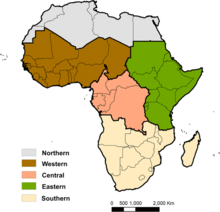
Only six African countries are not geopolitically a part of sub-Saharan Africa:Algeria,Egypt,Libya,Morocco,TunisiaandWestern Sahara(claimed by Morocco); they form theUN subregionofNorthern Africa,which also makes up the largest bloc of theArab World.Nevertheless, some international organisations include Sudan as part of North Africa. Although a long-standing member of theArab League,Sudan has around 30% non-Arab populations in the west (Darfur,Masalit,Zaghawa), far north (Nubian) and south (Kordofan,Nuba),[259][260][261][262][263][264]and a largely Arabized native Nubian population that represents the majority at 70% hence its inclusion in North Africa, but geographically and culturally Sudan is part of Sub Saharan Africa.MauritaniaandNigeronly include a band of the Sahel along their southern borders. All other African countries have at least significant portions of their territory within sub-Saharan Africa.
Central Africa
[edit]
 South Sudan[101][265]cap.Jubacur.South Sudanese pound(£)lang.English
South Sudan[101][265]cap.Jubacur.South Sudanese pound(£)lang.English
 Angola(also in SADC)cap.Luandacur.Angolan kwanza(Kz)lang.Portuguese
Angola(also in SADC)cap.Luandacur.Angolan kwanza(Kz)lang.Portuguese Burundi(also in EAC)cap.Gitega(formerBujumbura)cur.Burundian franc(FBu)lang.French
Burundi(also in EAC)cap.Gitega(formerBujumbura)cur.Burundian franc(FBu)lang.French Democratic Republic of the Congo(also in SADC)cap.Kinshasacur.Congolese franc(FC)lang.French
Democratic Republic of the Congo(also in SADC)cap.Kinshasacur.Congolese franc(FC)lang.French Rwanda(also in EAC)cap.Kigalicur.Rwandan franc(RF)lang.Kinyarwanda,French, English
Rwanda(also in EAC)cap.Kigalicur.Rwandan franc(RF)lang.Kinyarwanda,French, English São Tomé and Príncipecap.São Tomécur.São Tomé and Príncipe dobra(Db)lang.Portuguese
São Tomé and Príncipecap.São Tomécur.São Tomé and Príncipe dobra(Db)lang.Portuguese
 Camerooncap.Yaoundécur.Central African CFA franc(FCFA)lang.English, French
Camerooncap.Yaoundécur.Central African CFA franc(FCFA)lang.English, French Central African Republiccap.Banguicur.Central African CFA franc(FCFA)lang.Sango,French
Central African Republiccap.Banguicur.Central African CFA franc(FCFA)lang.Sango,French Chadcap.N'Djamenacur.Central African CFA franc(FCFA)lang.French, Arabic
Chadcap.N'Djamenacur.Central African CFA franc(FCFA)lang.French, Arabic Republic of the Congocap.Brazzavillecur.Central African CFA franc(FCFA)lang.French
Republic of the Congocap.Brazzavillecur.Central African CFA franc(FCFA)lang.French Equatorial Guineacap.Malabocur.Central African CFA franc(FCFA)lang.Spanish, French
Equatorial Guineacap.Malabocur.Central African CFA franc(FCFA)lang.Spanish, French Gaboncap.Librevillecur.Central African CFA franc(FCFA)lang.French
Gaboncap.Librevillecur.Central African CFA franc(FCFA)lang.French
East Africa
[edit]
 Sudancap.Khartoumcur.Sudanese pound(£S.)lang.Arabic (Sudanese Arabic) andEnglish
Sudancap.Khartoumcur.Sudanese pound(£S.)lang.Arabic (Sudanese Arabic) andEnglish South Sudancap.Jubacur.South Sudanese pound(£)lang.Englishand Arabic (Juba Arabic)
South Sudancap.Jubacur.South Sudanese pound(£)lang.Englishand Arabic (Juba Arabic) Somaliacap.Mogadishucur.Somali shilling(So.Sh /-)lang.Somali,Arabic(official)
Somaliacap.Mogadishucur.Somali shilling(So.Sh /-)lang.Somali,Arabic(official) Kenyacap.Nairobicur.Kenyan shilling(KSh /=)lang.Swahili,English
Kenyacap.Nairobicur.Kenyan shilling(KSh /=)lang.Swahili,English Ugandacap.Kampalacur.Ugandan shilling(USh /=)lang.Swahili,English
Ugandacap.Kampalacur.Ugandan shilling(USh /=)lang.Swahili,English Rwanda(also in ECCAS)cap.Kigalicur.Rwandan franc(RF)lang.Kinyarwanda,French, English
Rwanda(also in ECCAS)cap.Kigalicur.Rwandan franc(RF)lang.Kinyarwanda,French, English Tanzania(also in SADC)cap.Dodomacur.Tanzanian shilling(TSh /=)lang.Swahili,English
Tanzania(also in SADC)cap.Dodomacur.Tanzanian shilling(TSh /=)lang.Swahili,English Burundi(also in ECCAS)cap.Gitega(formerBujumbura)cur.Burundian franc(FBu)lang.Kirundi,French
Burundi(also in ECCAS)cap.Gitega(formerBujumbura)cur.Burundian franc(FBu)lang.Kirundi,French Eritreacap.Asmaracur.Eritrean nakfa(Nfk) 'lang.'Tigrinya,Arabic,Italian,English(unofficial, lingua franca)
Eritreacap.Asmaracur.Eritrean nakfa(Nfk) 'lang.'Tigrinya,Arabic,Italian,English(unofficial, lingua franca) Djibouticap.Djibouticur.Djiboutian franc(Fdj)lang.Arabic,French(official)
Djibouticap.Djibouticur.Djiboutian franc(Fdj)lang.Arabic,French(official)
Northeast Africa
[edit]- Horn of Africa
 Djibouticap.Djibouticur.Djiboutian franc(Fdj)lang.Arabic,French(official)
Djibouticap.Djibouticur.Djiboutian franc(Fdj)lang.Arabic,French(official) Eritreacap.Asmaracur.Eritrean nakfa(Nfk) 'lang.'Tigrinya,Arabic,Italian,English(unofficial, lingua franca)
Eritreacap.Asmaracur.Eritrean nakfa(Nfk) 'lang.'Tigrinya,Arabic,Italian,English(unofficial, lingua franca) Ethiopiacap.Addis Ababacur.Ethiopian birr(Br)lang.Afar,Amharic,Oromo,Somali,andTigrinya
Ethiopiacap.Addis Ababacur.Ethiopian birr(Br)lang.Afar,Amharic,Oromo,Somali,andTigrinya Somaliacap.Mogadishucur.Somali shilling(So.Sh)lang.Somali,Arabic(official)
Somaliacap.Mogadishucur.Somali shilling(So.Sh)lang.Somali,Arabic(official)
- Sudan & South Sudan
 Sudancap.Khartoumcur.Sudanese pound(£Sd.)lang.Arabic (Sudanese Arabic) andEnglish
Sudancap.Khartoumcur.Sudanese pound(£Sd.)lang.Arabic (Sudanese Arabic) andEnglish South Sudancap.Jubacur.South Sudanese pound(£)lang.Englishand Arabic (Juba Arabic)
South Sudancap.Jubacur.South Sudanese pound(£)lang.Englishand Arabic (Juba Arabic)
Southeast Africa
[edit]- EAC
 Burundi(also in ECCAS)cap.Gitega(formerBujumbura)cur.Burundian franc(FBu)lang.Kirundi,French
Burundi(also in ECCAS)cap.Gitega(formerBujumbura)cur.Burundian franc(FBu)lang.Kirundi,French Kenyacap.Nairobicur.Kenyan shilling(KSh /=)lang.Swahili,English
Kenyacap.Nairobicur.Kenyan shilling(KSh /=)lang.Swahili,English Rwanda(also in ECCAS)cap.Kigalicur.Rwandan franc(RF)lang.Kinyarwanda,French, English
Rwanda(also in ECCAS)cap.Kigalicur.Rwandan franc(RF)lang.Kinyarwanda,French, English Tanzania(also in SADC)cap.Dodomacur.Tanzanian shilling(TSh. /=)lang.Swahili,English
Tanzania(also in SADC)cap.Dodomacur.Tanzanian shilling(TSh. /=)lang.Swahili,English Ugandacap.Kampalacur.Ugandan shilling(USh /=)lang.Swahili,English
Ugandacap.Kampalacur.Ugandan shilling(USh /=)lang.Swahili,English
Southern Africa
[edit]
- SADC (Southern African Development Community)
 Angola(also in ECCAS)cap.Luandacur.Angolan kwanza(Kz)lang.Portuguese
Angola(also in ECCAS)cap.Luandacur.Angolan kwanza(Kz)lang.Portuguese Botswanacap.Gaboronecur.Botswana pula(P)lang.Tswana,English
Botswanacap.Gaboronecur.Botswana pula(P)lang.Tswana,English Comoroscap.Moronicur.Comorian franc(FC)lang.Comorian,Arabic, French
Comoroscap.Moronicur.Comorian franc(FC)lang.Comorian,Arabic, French Eswatinicap.Mbabanecur.Swazi lilangeni(L)(E)lang.SiSwati,English
Eswatinicap.Mbabanecur.Swazi lilangeni(L)(E)lang.SiSwati,English Lesothocap.Maserucur.Lesotho loti(L)(M)lang.Sesotho,English
Lesothocap.Maserucur.Lesotho loti(L)(M)lang.Sesotho,English Madagascarcap.Antananarivocur.Malagasy ariary(Ar.)lang.Malagasy,French
Madagascarcap.Antananarivocur.Malagasy ariary(Ar.)lang.Malagasy,French Malawicap.Lilongwecur.Malawian kwacha(MK)lang.English
Malawicap.Lilongwecur.Malawian kwacha(MK)lang.English Mauritiuscap.Port Louiscur.Mauritian rupee(Re/Rs /-)lang.English
Mauritiuscap.Port Louiscur.Mauritian rupee(Re/Rs /-)lang.English Mozambiquecap.Maputocur.Mozambican metical(MTn)lang.Portuguese
Mozambiquecap.Maputocur.Mozambican metical(MTn)lang.Portuguese Namibiacap.Windhoekcur.Namibian dollar(N$)lang.English
Namibiacap.Windhoekcur.Namibian dollar(N$)lang.English Seychellescap.Victoriacur.Seychellois rupee(Re/Rs /-)lang.Seychellois Creole,English, French
Seychellescap.Victoriacur.Seychellois rupee(Re/Rs /-)lang.Seychellois Creole,English, French South Africacap.Bloemfontein,Cape Town,Pretoriacur.South African rand(R)lang.11 official languages
South Africacap.Bloemfontein,Cape Town,Pretoriacur.South African rand(R)lang.11 official languages Zambiacap.Lusakacur.Zambian kwacha(ZK)lang.English
Zambiacap.Lusakacur.Zambian kwacha(ZK)lang.English Zimbabwecap.Hararecur.Zimbabwean dollar($)lang.English
Zimbabwecap.Hararecur.Zimbabwean dollar($)lang.English
Sudan
[edit]Depending on classificationSudanis often not considered part of sub-Saharan Africa, as it is considered part of North Africa.
 Sudancap.Khartoumcur.Sudanese pound(SDG)lang.Arabic and English
Sudancap.Khartoumcur.Sudanese pound(SDG)lang.Arabic and English
West Africa
[edit]
 Ivory Coastcap.Yamoussoukro,Abidjancur.West African CFA franc(CFA)
Ivory Coastcap.Yamoussoukro,Abidjancur.West African CFA franc(CFA) The Gambiacap.Banjulcur.Gambian dalasi(D)
The Gambiacap.Banjulcur.Gambian dalasi(D) Ghanacap.Accracur.Ghanaian cedi(GH₵)
Ghanacap.Accracur.Ghanaian cedi(GH₵) Guineacap.Conakrycur.Guinean franc(FG)
Guineacap.Conakrycur.Guinean franc(FG) Liberiacap.Monroviacur.Liberian dollar(L$)
Liberiacap.Monroviacur.Liberian dollar(L$) Mauritaniacap.Nouakchottcur.Mauritanian ouguiya(UM) (sometimes, likeSudan,considered part ofNorth Africa)
Mauritaniacap.Nouakchottcur.Mauritanian ouguiya(UM) (sometimes, likeSudan,considered part ofNorth Africa) Nigeriacap.Abujacur.Nigerian naira(₦)
Nigeriacap.Abujacur.Nigerian naira(₦) Sierra Leonecap.Freetowncur.Sierra Leonean leone(Le)
Sierra Leonecap.Freetowncur.Sierra Leonean leone(Le)
 Benincap.Porto-Novocur.West African CFA franc(CFA)
Benincap.Porto-Novocur.West African CFA franc(CFA) Burkina Fasocap.Ouagadougoucur.West African CFA franc(CFA)
Burkina Fasocap.Ouagadougoucur.West African CFA franc(CFA) Ivory Coastcap.Yamoussoukro,Abidjancur.West African CFA franc(CFA)
Ivory Coastcap.Yamoussoukro,Abidjancur.West African CFA franc(CFA) Guinea-Bissaucap.Bissaucur.West African CFA franc(CFA)
Guinea-Bissaucap.Bissaucur.West African CFA franc(CFA) Malicap.Bamakocur.West African CFA franc(CFA)
Malicap.Bamakocur.West African CFA franc(CFA) Nigercap.Niameycur.West African CFA franc(CFA)
Nigercap.Niameycur.West African CFA franc(CFA) Senegalcap.Dakarcur.West African CFA franc(CFA)
Senegalcap.Dakarcur.West African CFA franc(CFA) Togocap.Lomécur.West African CFA franc(CFA)
Togocap.Lomécur.West African CFA franc(CFA)
See also
[edit]References
[edit]- ^"Sub-Saharan Africa Demographics".Pew-Templeton Global Religious Futures Project. Archived fromthe originalon 11 September 2022.Retrieved11 September2022.
- ^"Composition of macro geographical (continental) regions, geographical sub-regions, and selected economic other groupings".United Nations Statistics Division. 11 February 2013.Retrieved20 July2013."The designation sub-Saharan Africa is commonly used to indicate all of Africa except northern Africa, with the Sudan included in sub-Saharan Africa."
- ^ecosostenibile (2 February 2023)."Afrotropical ecozone: boundaries, characteristics, biomes..."An Eco-sustainable World.Retrieved9 August2023.
- ^"Political definition of 'Major regions', according to the UN".Archived fromthe originalon 20 April 2010.Retrieved15 December2010.
- ^
- "League of Arab States".Archivedfrom the original on 28 July 2017.
- "Arab States".UNESCO.Archivedfrom the original on 19 November 2016.Retrieved20 November2016.
- Infosamak."Centre for Marketing, Information and Advisory Services for Fishery Products in the Arab Region".Infosamak.Archivedfrom the original on 8 March 2016.Retrieved30 August2009.
- Barakat, Halim (14 October 1993).The Arab World: Society, Culture, and State.University of California Press.p. 80.ISBN978-0-520-0790-76.
- Markakis, John (23 January 1998).Resource Conflict in the Horn of Africa.SAGE Publishing.p. 39.ISBN978-0-803-9884-77.
- Erlikh, Ḥagai (1983).The Struggle Over Eritrea, 1962-1978: War and Revolution in the Horn of Africa.Hoover Institution Press.p. 59.ISBN978-0-817-9760-26.
- Fegley, Randall (1995). "Eritrea".World Bibliographical Series.Vol. 181.Clio Press.p. mxxxviii.ISBN978-1-851-0924-51.
- Frishkopf, Michael A. (2010).Music and Media in the Arab World.American University in Cairo Press.p. 61.ISBN978-9-774-1629-30.Archived fromthe originalon 28 July 2020.
- ^"About Africa".UNDP in Africa.Archivedfrom the original on 11 April 2020.Retrieved15 March2020.
- ^"Sahara's Abrupt Desertification Started by Changes in Earth's Orbit, Accelerated by Atmospheric and Vegetation Feedbacks".ScienceDaily.12 July 1999. Archived fromthe originalon 7 March 2014.Retrieved7 March2014.
- ^
- Claussen, Mark; Kubatzki, Claudia; Brovkin, Victor; Ganopolski, Andrey; Hoelzmann, Philipp; Pachur, Hans-Joachim (1999)."Simulation of an Abrupt Change in Saharan Vegetation in the Mid-Holocene"(PDF).Geophysical Research Letters.26(14): 2037–40.Bibcode:1999GeoRL..26.2037C.doi:10.1029/1999GL900494.hdl:11858/00-001M-0000-0013-FBE4-E.S2CID6463581.Archived(PDF)from the original on 8 August 2017.Retrieved29 October2018.
- "Sahara's Abrupt Desertification Started By Changes In Earth's Orbit, Accelerated By Atmospheric And Vegetation Feedbacks".Science Daily.12 July 1999.Archivedfrom the original on 7 March 2014.Retrieved28 February2018.
- ^van Zinderen-Bakker, E.M. (14 April 1962). "A Late-Glacial and Post-Glacial Climatic Correlation between East Africa and Europe".Nature.194(4824): 201–03.Bibcode:1962Natur.194..201V.doi:10.1038/194201a0.S2CID186244151.
- ^abcdRaunig, Walter (2005).Afrikas Horn: Akten der Ersten Internationalen Littmann-Konferenz 2. bis 5. Mai 2002 in München.Otto Harrassowitz Verlag. p. 130.ISBN3-447-05175-2.Retrieved9 June2016.
ancient Arabic geography had quite a fixed pattern in listing the countries from the Red Sea to the Indian Ocean: These are al-Misr (Egypt) – al-Muqurra (or other designations for Nubian kingdoms) – al-Habasha (Abyssinia) – Barbara (Berber, i.e. the Somali coast) – Zanj (Azania, i.e. the country of the "blacks" ). Correspondingly almost all these terms (or as I believe: all of them!) also appear in ancient and medieval Chinese geography
- ^International Association for the History of Religions (1959),Numen,Leiden: EJ Brill, p. 131,
West Africa may be taken as the country stretching from Senegal in the west, to the Cameroons in the east; sometimes it has been called the central and western Sudan, the Bilad as-Sūdan, 'Land of the Blacks', of the Arabs
- ^abNehemia Levtzion,Randall Lee Pouwels, The History of Islam in Africa, (Ohio University Press, 2000), p. 255.
- ^Sven Rubenson, The survival of Ethiopian independence, (Tsehai, 2003), p. 30.
- ^Jonah Blank, Mullahs on the mainframe: Islam and modernity among the Daudi Bohras, (University of Chicago Press, 2001), p. 163.
- ^F.R.C. Bagley et al.,The Last Great Muslim Empires,(Brill: 1997), p. 174
- ^Bethwell A. Ogot,Zamani: A Survey of East African History,(East African Publishing House: 1974), p. 104
- ^James Hastings,Encyclopedia of Religion and Ethics Part 12: V. 12,(Kessinger Publishing, LLC: 2003), p. 490
- ^"black Africa".Cambridge Dictionary.Cambridge University.Archivedfrom the original on 20 January 2018.Retrieved13 March2021.
- ^Shillington, Kevin(2005). History of Africa, Rev. 2nd Ed. New York:Palgrave Macmillan,p. 2,ISBN0-333-59957-8.
- ^abShillington, Kevin(2005). History of Africa, Rev. 2nd Ed. New York: Palgrave Macmillan, pp. 2–3,ISBN0-333-59957-8.
- ^Shillington, Kevin(2005). History of Africa, Rev. 2nd Ed. New York: Palgrave Macmillan, p. 3,ISBN0-333-59957-8.
- ^Schlebusch; et al. (3 November 2017)."Southern African ancient genomes estimate modern human divergence to 350,000 to 260,000 years ago".Science.358(6363): 652–655.Bibcode:2017Sci...358..652S.doi:10.1126/science.aao6266.PMID28971970.
- ^Mounier, Aurélien; Lahr, Marta (2019)."Deciphering African late middle Pleistocene hominin diversity and the origin of our species".Nature Communications.10(1): 3406.Bibcode:2019NatCo..10.3406M.doi:10.1038/s41467-019-11213-w.PMC6736881.PMID31506422.
- ^Scerri, Eleanor M. L.; Thomas, Mark G.; Manica, Andrea; Gunz, Philipp; Stock, Jay T.; Stringer, Chris; Grove, Matt; Groucutt, Huw S.;Timmermann, Axel;Rightmire, G. Philip; d’Errico, Francesco (1 August 2018)."Did Our Species Evolve in Subdivided Populations across Africa, and Why Does It Matter?".Trends in Ecology & Evolution.33(8): 582–594.Bibcode:2018TEcoE..33..582S.doi:10.1016/j.tree.2018.05.005.ISSN0169-5347.PMC6092560.PMID30007846.
- ^Tishkoff SA, Reed FA, Friedlaender FR, et al. (May 2009)."The genetic structure and history of Africans and African Americans".Science.324(5930): 1035–44.Bibcode:2009Sci...324.1035T.doi:10.1126/science.1172257.PMC2947357.PMID19407144.
- ^Bradley, Simon (18 January 2007)."Swiss archaeologist digs up West Africa's past".SWI swissinfo.ch.Swiss Broadcasting Corporation. Archived fromthe originalon 6 March 2012.
- ^Jesse, Friederike (2010). "Early Pottery in Northern Africa - An Overview".Journal of African Archaeology.8(2): 219–238.doi:10.3213/1612-1651-10171.JSTOR43135518.
- ^Stearns, Peter N. (2001)The Encyclopedia of World History,Houghton Mifflin Books. p. 16.ISBN0-395-65237-5.
- ^Collins, Robert O. and Burns, James. M(2007). A History of Sub-saharan Africa. Cambridge:Cambridge University Press,p. 62,ISBN978-0-521-86746-7
- ^Davidson, Basil. Africa History, Themes and Outlines, revised and expanded edition. New York:Simon & Schuster,p. 54,ISBN0-684-82667-4.
- ^Shillington, Kevin(2005). History of Africa, Rev. 2nd Ed. New York: Palgrave Macmillan, p. 47,ISBN0-333-59957-8.
- ^McEvedy, Colin (1980)Atlas of African History,p. 44.ISBN0-87196-480-5.
- ^Breunig, Peter. 2014. Nok: African Sculpture in Archaeological Context: p. 21.
- ^Davidson, Basil.Africa History, Themes and Outlines,revised and expanded edition. New York: Simon & Schuster, pp. 87–107,ISBN0-684-82667-4.
- ^Meyerowitz, Eva L. R. (1975).The Early History of the Akan States of Ghana.Red Candle Press.ISBN9780608390352.
- ^"The Slave Trade".Countrystudies.us.Archivedfrom the original on 23 June 2011.Retrieved9 June2008.
- ^Philippe Lavachery; et al. (2012).Komé-Kribi: Rescue Archaeology Along the Chad-Cameroon Oil Pipeline.
- ^É. Zangato; A.F.C. Holl (2010)."On the Iron Front: New Evidence from North-Central Africa".Journal of African Archaeology.8(1): 7–23.doi:10.3213/1612-1651-10153.Archived fromthe originalon 26 December 2013.
- ^J. Cameron Monroe.Akinwumi Ogundiran, Power and Landscape in Atlantic West Africa: Archaeological Perspectives.p. 316.,citing Magnavita 2004; Magnavita et al. 2004, 2006; Magnavita and Schleifer 2004.
- ^Peter Mitchell et al., The Oxford Handbook of African Archeology (2013), p. 855: "The relatively recent discovery of extensive walled settlements at the transition from the Neolithic to the Early Iron Age in the Chad Basin (Magnavita et al., 2006) indicates what enormous sites and processes may still await recognition."
- ^Appiah & Gates 2010,p. 254.
- ^abcShillington, Kevin(2005). History of Africa, Rev. 2nd Ed. New York: Palgrave Macmillan, pp. 138–39, 142,ISBN0-333-59957-8.
- ^Thompson, Lloyd A. (1989).Romans and blacks.Taylor & Francis.p. 57.ISBN0-415-03185-0.Archivedfrom the original on 30 March 2021.Retrieved20 October2020.
- ^Mokhtar (editor), AnciGent Civilizations of Africa Vo. II, General History of Africa, UNESCO, 1990
- ^Oman in history By Peter Vine Page 324
- ^Shaping of Somali society Lee Cassanelli pg.92
- ^Futuh Al Habash Shibab ad Din
- ^Sudan Notes and Records – 147
- ^Somali Sultanate: The Geledi City-state Over 150 Years - Virginia Luling (2002) Page 229
- ^Mukhtar, Mohamed Haji (25 February 2003).Historical Dictionary of Somalia.Scarecrow Press. p. xxix.ISBN9780810866041.Archivedfrom the original on 16 December 2019.Retrieved15 February2014.
- ^Liu, Hua; Prugnolle, Franck; Manica, Andrea;Balloux, François(2006)."A Geographically Explicit Genetic Model of Worldwide Human-Settlement History".The American Journal of Human Genetics.79(2): 230–237.doi:10.1086/505436.PMC1559480.PMID16826514.
- ^James De Vere Allen (1993).Swahili Origins: Swahili Culture & the Shungwaya Phenomenon.
- ^Daniel Don Nanjira, African Foreign Policy and Diplomacy: From Antiquity to the 21st Century, ABC-CLIO, 2010, p. 114
- ^Jens Finke (2010).The Rough Guide to Tanzania.Rough Guides Limited.ISBN9781848360754.
- ^Casson, Lionel (1989). The Periplus Maris Erythraei. Lionel Casson. (Translation by H. Frisk, 1927, with updates and improvements and detailed notes). Princeton, Princeton University Press.
- ^Chami, F. A. (1999). "The Early Iron Age on Mafia island and its relationship with the mainland." Azania Vol. XXXIV 1999, pp. 1–10.
- ^Chami, Felix A. 2002. "The Egypto-Graeco-Romans and Paanchea/Azania: sailing in the Erythraean Sea." From: Red Sea Trade and Travel. The British Museum. Sunday 6 October 2002. Organised by The Society for Arabian Studies
- ^"Weilue: The Peoples of the West".Depts.washington.edu. 23 May 2004.Archivedfrom the original on 23 December 2017.Retrieved29 September2015.
- ^Miller, J. Innes. 1969. Chapter 8: "The Cinnamon Route". In: The Spice Trade of the Roman Empire. Oxford: University Press.ISBN0-19-814264-1
- ^Klein, Martin A.; Wesley Johnson, G. (8 January 2010).Perspectives on the African past.Archivedfrom the original on 27 June 2020.Retrieved10 August2018.
- ^Yu Huan (September 2004) [429 CE]."The Peoples of the West from the Weilue: A Third Century Chinese Account Composed between 239 and 265 CE".Translated by Hill, John E. Section 15 and notes. Archived fromthe originalon 15 March 2005.Retrieved17 September2016– via Silk Road Seattle.
- ^Evelyne Jone Rich; Immanuel Maurice Wallerstein (1971).Africa: Tradition and Change.Random House School Division. p. 124.ISBN9780394009384.Archivedfrom the original on 10 May 2016.Retrieved9 June2016.
- ^Rhonda M. Gonzales (30 August 2009).Societies, religion, and history: central-east Tanzanians and the world they created, c. 200 BCE to 1800 CE.Columbia University Press.p. 222.ISBN978-0-231-14242-7.Archivedfrom the original on 10 June 2016.Retrieved9 June2016.
- ^abRoland Oliver, et al. "Africa South of the Equator," in Africa Since 1800. Cambridge, UK: Cambridge University Press, 2005, pp. 24–25.
- ^M. Martin, Phyllis and O'Meara, Patrick (1995).Africa.3rd edition, Bloomington and Indianapolis:Indiana University Press,p. 156,ISBN0-253-32916-7.
- ^"World Population Prospects 2022".United Nations Department of Economic and Social Affairs,Population Division.Retrieved17 July2022.
- ^"World Population Prospects 2022: Demographic indicators by region, subregion and country, annually for 1950-2100"(XSLX)( "Total Population, as of 1 July (thousands)" ).United Nations Department of Economic and Social Affairs,Population Division.Retrieved17 July2022.
- ^"World Population Prospects 2019 – Population Division".Esa.un.org. 28 August 2019.Archivedfrom the original on 15 June 2020.Retrieved22 December2019.
- ^"Fertility rate, total (births per woman) | Data".data.worldbank.org.Archivedfrom the original on 8 July 2016.Retrieved21 July2016.
- ^According to theCIA FactbookArchived5 August 2012 atarchive.today:Angola, Benin, Burundi, Burkina Faso, the Central African Republic, Cameroon, Chad, the Republic of Congo, the Democratic Republic of Congo, Djibouti, Equatorial Guinea, Eritrea, Ethiopia, Gabon, the Gambia, Ghana, Guinea, Guinea-Bissau, Kenya, Liberia, Madagascar, Malawi, Mali, Mauritania, Mozambique, Namibia, Nigeria, Rwanda, Senegal, Sierra Leone, Somalia, Sudan, Swaziland, Tanzania, Togo, Uganda, and Zambia
- ^ab(2009). Africa Development Indicators 2008/2009: From the World Bank Africa Database African Development Indicators. World Bank Publications, p. 28,ISBN978-0-8213-7787-1.
- ^"Country Comparison:: GDP - per capita (PPP) — The World Factbook - Central Intelligence Agency".cia.gov.Archived fromthe originalon 14 January 2020.Retrieved2 January2020.
- ^"Research – CPI – Overview".Transparency.org.Archivedfrom the original on 12 January 2019.Retrieved29 September2015.
- ^"Rankings - Doing Business".The Doing Business Project.World Bank. 2010. Archived fromthe originalon 7 April 2010.Retrieved25 May2023.
- ^"National Literacy Survey".National Bureau of Statistics. June 2010. Archived fromthe originalon 17 September 2015.Retrieved5 September2015.
- ^"The World Factbook".Cia.gov. Archived fromthe originalon 28 May 2014.Retrieved29 September2015.
- ^Brown, Keith and Ogilvie, Sarah(2008). Concise encyclopedia of languages of the worldConcise Encyclopedias of Language and Linguistics Series.Elsevier, p. 12,ISBN978-0-08-087774-7.
- ^Maaroufi, Youssef."Recensement général de la population et de l'habitat 2004".Archived fromthe originalon 6 September 2017.Retrieved26 July2017.
- ^Lafkioui, Mena B. (24 May 2018)."Berber Languages and Linguistics"(PDF).Oxford Bibliographies.doi:10.1093/OBO/9780199772810-0219.Archived fromthe original(PDF)on 3 February 2023.Retrieved25 May2023.
- ^Peek, Philip M. and Yankah, Kwesi (2004). African folklore: an encyclopedia. London: (Routledge) Taylor & Francis, p. 205,ISBN0-415-93933-X,9780415939331
- ^Schneider, Edgar Werner and Kortmann, Bernd(2004). A handbook of varieties of English: a multimedia reference tool, Volume 1. Berlin:Walter de Gruyter,pp. 867–68,ISBN978-3-11-017532-5.
- ^Güldemann, Tom and Edward D. Elderkin (forthcoming)"On external genealogical relationships of the Khoe family".Archived25 March 2009 at theWayback MachineIn Brenzinger, Matthias and Christa König (eds.),Khoisan languages and linguistics: the Riezlern symposium 2003.Quellen zur Khoisan-Forschung 17. Köln: Rüdiger Köppe.
- ^Bellwood, Peter S.(2005). First farmers: the origins of agricultural societies. Wiley-Blackwell, p. 218,ISBN978-0-631-20566-1.
- ^abc"Congo, Democratic Republic of the",The World Factbook,Central Intelligence Agency, 22 May 2023, archived fromthe originalon 24 May 2023,retrieved25 May2023
- ^"Rwanda",The World Factbook,Central Intelligence Agency, 16 May 2023, archived fromthe originalon 24 May 2023,retrieved25 May2023
- ^ab"Angola",The World Factbook,Central Intelligence Agency, 16 May 2023, archived fromthe originalon 24 May 2023,retrieved25 May2023
- ^"Congo, Republic of the",The World Factbook,Central Intelligence Agency, 16 May 2023, archived fromthe originalon 24 May 2023,retrieved25 May2023
- ^"Burundi",The World Factbook,Central Intelligence Agency, 16 May 2023, archived fromthe originalon 24 May 2023,retrieved25 May2023
- ^"Memories of Utopia – Infoshop, World Bank"(PDF).secid.org.South East Consortium for International Development. 31 May 2006. Archived fromthe original(PDF)on 6 April 2012.Retrieved14 October2015.
- ^"SSI Finance – Loans and lending guide".Retrieved12 February2023.
- ^John A. Shoup (2011).Ethnic Groups of Africa and the Middle East.p. 333."The Zaghawa is one of the major divisions of the Beri peoples who live in western Sudan and eastern Chad, and their language, also called Zaghawa, belongs to the Saharan branch of the Nilo-Saharan language group."
- ^"Sudan",The World Factbook,Central Intelligence Agency, 23 May 2023, archived fromthe originalon 24 May 2023,retrieved25 May2023
- ^"Summary and Statistical Report of the 2007: Population and Housing Census Results"(PDF).New York City:United Nations Population Fund.2007. Archived fromthe original(PDF)on 5 March 2009.Retrieved14 October2015.
- ^"Eritrea",The World Factbook,Central Intelligence Agency, 16 May 2023, archived fromthe originalon 24 May 2023,retrieved25 May2023
- ^"Report on minority groups in Somalia"(PDF).somraf.org.Archived fromthe original(PDF)on 21 October 2013.Retrieved14 October2015.
- ^"Somalia",The World Factbook,Central Intelligence Agency, 16 May 2023, archived fromthe originalon 24 May 2023,retrieved25 May2023
- ^abcd"Kenya",The World Factbook,Central Intelligence Agency, 7 February 2023,retrieved12 February2023
- ^"20 million people can speak Luganda - linguists".New Vision.
- ^"Malagasy".Ethnologue.Archived fromthe originalon 25 May 2023.Retrieved25 May2023.
- ^abc"Central African Republic"Archived10 January 2021 at theWayback Machine.CIA World Factbook. Retrieved 13 November 2014.
- ^abcde"South Sudan"Archived12 January 2021 at theWayback Machine.CIA World Factbook. Retrieved 13 November 2014.
- ^abcdef"Nigeria".CIA World Factbook. Retrieved 13 November 2014.
- ^abcdef"Niger"Archived30 March 2021 at theWayback Machine.CIA World Factbook. Retrieved 13 November 2014.
- ^abc"Chad"Archived26 January 2021 at theWayback Machine.CIA World Factbook. Retrieved 16 November 2014.
- ^"Uganda",The World Factbook,Central Intelligence Agency, 6 February 2023,retrieved12 February2023
- ^"Population and Housing Census".knbs.or.ke.Kenya National Bureau of Statistics. 2009. Archived fromthe originalon 2 February 2014.Retrieved14 October2015.
- ^"The Maasai of Kenya and Tanzania".The Language Journal. 22 April 2012.Archivedfrom the original on 5 September 2015.Retrieved29 September2015.
- ^abcd"South Africa"Archived10 January 2021 at theWayback Machine.CIA World Factbook. Retrieved 16 November 2014.
- ^"Botswana"Archived9 January 2021 at theWayback Machine.CIA World Factbook. 20 November 2014.
- ^"Malawi"Archived4 February 2021 at theWayback Machine.CIA World Factbook. Retrieved 16 November 2014.
- ^"Zambia"Archived26 January 2021 at theWayback Machine.CIA World Factbook. 20 November 2014.
- ^"Mozambique"Archived10 January 2021 at theWayback Machine.CIA World Factbook. 20 November 2014.
- ^"The Future of Portuguese".BB Portuguese. Archived fromthe originalon 2 May 2012.Retrieved11 April2012.
- ^ab"Senegal"Archived4 February 2021 at theWayback Machine.CIA World Factbook. Retrieved 20 November 2014.
- ^ab"The Gambia"Archived1 February 2021 at theWayback Machine.CIA World Factbook. Retrieved 20 November 2014.
- ^"Cameroon"Archived20 January 2021 at theWayback Machine.CIA World Factbook. Retrieved 20 November 2014.
- ^abc"Mali"Archived30 March 2021 at theWayback Machine.CIA World Factbook. Retrieved 20 November 2014.
- ^African Cities Driving the NEPAD Initiative.UN-HABITAT. 2006. p. 202.ISBN9789211318159.Archivedfrom the original on 30 March 2021.Retrieved4 July2018.
- ^John Hartley; Jason Potts; Terry Flew; Stuart Cunningham; Michael Keane; John Banks (2012).Key Concepts in Creative Industries.SAGE. p. 47.ISBN978-1-446-2028-90.Archivedfrom the original on 30 March 2021.Retrieved4 July2018.
- ^Helmut K Anheier; Yudhishthir Raj Isar (2012).Cultures and Globalization: Cities, Cultural Policy and Governance.SAGE. p. 118.ISBN9781446258507.Archivedfrom the original on 14 December 2020.Retrieved4 July2018.
- ^Stuart Cunningham (2013).Hidden Innovation: Policy, Industry and the Creative Sector (Creative Economy and Innovation Culture Se Series).University of Queensland Press.p. 163.ISBN978-0-702-2509-89.Archivedfrom the original on 8 January 2020.Retrieved4 July2018.
- ^Lisa Benton-Short;John Rennie Short(2013).Cities and Nature.Routledge Critical Introductions to Urbanism and the City. p. 71.ISBN9781134252749.Archivedfrom the original on 30 March 2021.Retrieved4 July2018.
- ^Kerstin Pinther; Larissa Förster; Christian Hanussek (2012).Afropolis: City Media Art.Jacana Media. p. 18.ISBN978-1-431-4032-57.Archivedfrom the original on 30 March 2021.Retrieved4 July2018.
- ^Salif Diop; Jean-Paul Barusseau; Cyr Descamps (2014).The Land/Ocean Interactions in the Coastal Zone of West and Central Africa Estuaries of the World.Springer. p. 66.ISBN978-3-319-0638-81.Archivedfrom the original on 30 March 2021.Retrieved4 July2018.
- ^"What Makes Lagos a Model City".The New York Times.7 January 2014.Archivedfrom the original on 19 May 2019.Retrieved16 March2015.
- ^John Campbell (10 July 2012)."This Is Africa's New Biggest City: Lagos, Nigeria, Population 21 Million".The Atlantic.Washington D.C.Archivedfrom the original on 30 March 2021.Retrieved23 September2012.
- ^"Lagos and Its Potentials for Economic Growth".2 July 2015.Archivedfrom the original on 9 October 2015.Retrieved26 October2015.
- ^"Africa's biggest shipping ports".Businesstech. 8 March 2015.Archivedfrom the original on 5 November 2015.Retrieved26 October2015.
- ^Brian Rajewski (1998).Africa, Volume 1 of Cities of the world: a compilation of current information on cultural, geographical, and political conditions in the countries and cities of six continents, based on the Department of State's "post reports".Gale Research International, Limited.ISBN9780810376922.
- ^Loretta Lees; Hyun Bang Shin; Ernesto López Morales (2015).Global Gentrifications: Uneven Development and Displacement.Policy Press. p. 315.ISBN978-1-447-3134-89.Archivedfrom the original on 30 March 2021.Retrieved4 July2018.
- ^"Major urban areas - population".cia.gov.Archived fromthe originalon 4 May 2012.Retrieved18 November2014.
- ^"Johannesburg".Archivedfrom the original on 26 April 2015.Retrieved25 May2015.
- ^Pulse Africa."Not to be Missed: Nairobi 'Green City in the Sun'".pulseafrica. Archived fromthe originalon 28 April 2007.Retrieved14 June2007.
- ^Pugliese, Jessica (2 January 2014)."Rethinking Financing for Development in Sub-Saharan Africa".Brookings Institution.Archivedfrom the original on 6 January 2014.Retrieved5 January2014.
- ^"Africa's impressive growth".World Bank. 29 August 2014.Archivedfrom the original on 1 September 2014.Retrieved29 August2014.
- ^Bank, European Investment (19 October 2022).Finance in Africa - Navigating the financial landscape in turbulent times.European Investment Bank.ISBN978-92-861-5382-2.
- ^"Africa might have dodged a bullet, but systemic warnings abound for poverty reduction efforts on the continent".blogs.worldbank.org.28 September 2022.Retrieved28 October2022.
- ^"Extreme poverty rises in West Africa due to COVID-19 pandemic | World Food Programme".wfp.org.20 January 2022.Retrieved28 October2022.
- ^"COVID-19 and Africa: Socio-economic implications and policy responses".OECD.Retrieved28 October2022.
- ^"For Sub-Saharan Africa, Coronavirus Crisis Calls for Policies for Greater Resilience".World Bank.Retrieved28 October2022.
- ^Mukhopadhyay, Abhijit."The Search for Sustainable Solutions to Debt Accumulation in Sub-Saharan Africa".ORF.Retrieved28 October2022.
- ^"Africa's Rapid Economic Growth Hasn't Fully Closed Income Gaps".IMF.21 September 2022.Retrieved28 October2022.
- ^"Sub-Saharan Africa: Living on The Edge".IMF.Retrieved28 October2022.
- ^"Growing Together The IMF and African Low-Income Countries".IMF.Retrieved28 October2022.
- ^"Sub-Saharan Africa: A New Shock and Little Room to Maneuver".IMF.Retrieved28 October2022.
- ^"Electricity Production Data | World Electricity Statistics | Enerdata".yearbook.enerdata.net.Retrieved19 February2023.
- ^Creamer Media Reporter (12 November 2009)."Africa's energy problems threatens growth, says Nepad CEO".engineeringnews.co.za.Engineering News. Archived fromthe originalon 4 June 2013.Retrieved14 October2015.
- ^ab"Access to energy is Africa development key".European Investment Bank.Retrieved7 June2021.
- ^"Access to electricity – SDG7: Data and Projections – Analysis".IEA.Retrieved7 June2021.
- ^"More than half of sub-Saharan Africans lack access to electricity".The Economist.13 November 2019.ISSN0013-0613.Retrieved7 June2021.
- ^abcdefghijklmnChristian K.M. Kingombe 2011.Mapping the new infrastructure financing landscapeArchived18 September 2012 at theWayback Machine.London:Overseas Development Institute
- ^"Creamer Media"(PDF).Us-cdn.creamermedia.co.za.Archived(PDF)from the original on 7 August 2020.Retrieved29 September2015.
- ^"Nuclear Vs Solar Energy, Which?".Redorbit.24 March 2006.Archivedfrom the original on 20 May 2013.Retrieved12 February2023.
- ^Zych, Ariel."Blog: Battle of the Bots".Science Friday.Archivedfrom the original on 28 July 2020.Retrieved12 February2023.
- ^Hepeng, Jia (20 August 2004)."China to train developing nations in solar technologies".scidev.net.Archivedfrom the original on 3 November 2009.Retrieved14 November2009.
- ^"About | Renewable Energy Performance Platform (REPP)".REPP.Retrieved7 June2021.
- ^abEnglish, Cynthia (23 June 2008)."Radio the Chief Medium for News in Sub-Saharan Africa".Gallup.Archivedfrom the original on 17 November 2009.Retrieved12 February2023.
- ^"Africa calling: Cellphone usage sees record rise".The Mail & Guardian.23 October 2009.Archivedfrom the original on 25 October 2009.Retrieved12 February2023.
- ^Aker, Jenny C.(2008)."Can You Hear Me Now?" How Cell Phones are Transforming Markets in Sub-Saharan AfricaArchived4 March 2016 at theWayback Machine,Center for Global Development.
- ^"MG.co.za".MG.co.za. 23 December 2009.Archivedfrom the original on 26 December 2009.Retrieved27 December2009.
- ^Pfanner, Eric (6 August 2007)."Competition increases for pay TV in sub-Saharan Africa".The New York Times.ISSN0362-4331.Retrieved12 February2023.
- ^Lisa A. Corathers (January 2009)."Manganese"(PDF).Minerals.usgs.gov.Archived(PDF)from the original on 4 March 2016.Retrieved19 October2015.
Land-based manganese resources are large but irregularly distributed; those of the United States are very low grade and have potentially high extraction costs. South Africa accounts for about 80% of the world's identified manganese resources, and Ukraine accounts for 10%.
- ^abChen, Wenjie; Laws, Athene; Valckx, Nico."Harnessing Sub-Saharan Africa's Critical Mineral Wealth".IMF.Retrieved13 May2024.
- ^John F. Papp (2001)."Chromium"(PDF).U.S. Geological Survey Minerals Yearbook.Minerals.usgs.gov.Archived(PDF)from the original on 10 September 2015.Retrieved19 October2015.
About 42% of world reserves and about 75% of the world reserve base are located in South Africa.
- ^Vronsky (1 May 1997)."Platinum: The Rich Man's Gold".Gold-Eagle.Archivedfrom the original on 12 March 2013.Retrieved19 October2015.
- ^E. Lee Bray (January 2009)."Bauxite and Alumina"(PDF).U.S. Geological Survey, Mineral Commodity Summaries.Minerals.usgs.gov.Archived(PDF)from the original on 24 November 2018.Retrieved29 September2015.
- ^Daniel L. Edelstein (January 2009)."Copper"(PDF).U.S. Geological Survey, Mineral Commodity Summaries.Minerals.usgs.gov.Archived(PDF)from the original on 4 March 2016.Retrieved19 October2015.
- ^"From the SelectedWorks of Maheta Matteo: From" Blood Diamond "to" Blood Coltan ": Should International Corporations Pay the Price for the Rape of the DR Congo?".Works.bepress. Archived fromthe originalon 30 September 2015.Retrieved29 September2015.
- ^"MBendi".MBendi. Archived fromthe originalon 10 May 2006.Retrieved20 December2009.
- ^"World-Nuclear.org".World-Nuclear.org.Archivedfrom the original on 26 June 2010.Retrieved20 December2009.
- ^Ghazvinian, John (2008). Untapped: The Scramble for Africa's Oil. Houghton Mifflin Harcourt, pp. 1–16,ISBN978-0-15-603372-5.
- ^abChristopher Ehret,(2002). The Civilization of Africa. University of Virginia Press: Charlottesville, p. 98,ISBN0-8139-2085-X.
- ^Vandaveer, Chelsie(2006).What was the cotton of Kush?Archived14 January 2010 at theWayback MachineKillerPlants, Plants That Change History Archive.
- ^National Research Council (U.S.). Board on Science and Technology for International Development (1996). Lost Crops of Africa: Grains. National Academy Press,ISBN978-0-309-04990-0.
- ^"WorldDefenseReview".WorldDefenseReview.Archivedfrom the original on 7 November 2009.Retrieved13 November2009.
- ^"Large scale land investments, household displacement and the effect on land degradation in semiarid agro-pastoral areas of Ethiopia".
- ^Bowden, Rob (2007). Africa South of the Sahara. Coughlan Publishing: p. 37,ISBN1-4034-9910-1.
- ^Evans, Ambrose (12 October 2009)."Blogspot".Tradeafrica.blogspot.Archivedfrom the original on 25 May 2014.Retrieved15 November2009.
- ^"Africa Regional Brief"(PDF).World Bank.Archived(PDF)from the original on 25 May 2014.Retrieved7 May2012.
- ^abcSaul, John J.; Leys, Colin (1 July 1999)."Sub-Saharan Africa in Global Capitalism".Monthly Review.51(3). Archived fromthe originalon 31 May 2014.Retrieved12 February2023.
- ^abcMagdoff, Fred (1 November 2013)."Twenty-First-Century Land Grabs: Accumulation by Agricultural Dispossession".Monthly Review.65(6).doi:10.14452/MR-065-06-2013-10_1.S2CID144627886.Archived fromthe originalon 31 May 2014.Retrieved12 February2023.
- ^Mathiason, Nick (2 November 2009)."Global protocol could limit Sub-Saharan land grab".The Guardian.London.Archivedfrom the original on 8 September 2013.Retrieved9 April2010.
- ^Ken Gwilliam, Vivien Foster, Rodrigo Archondo-Callao, Cecilia Briceño-Garmendia, Alberto Nogales, and Kavita Sethi(2008).Africa infrastructure country diagnostic, Roads in Sub-Saharan AfricaArchived18 July 2011 at theWayback Machine.World Bank and the SSATP: p. 4
- ^abGabara, Nthambeleni (12 November 2009)."Developed nations should invest in African universities".buanews.gov.za.BuaNews Online. Archived fromthe originalon 23 February 2012.Retrieved16 October2015.
- ^Firsing, Scott (18 January 2016)."How severe is Africa's Brain Drain?".London School of Economics Blogs.Archivedfrom the original on 12 November 2020.Retrieved2 December2020.
- ^Ngwé, Luc (24 January 2018)."African brain drain: is there an alternative?".UNESCO.Archivedfrom the original on 11 May 2020.Retrieved2 December2020.
- ^"World".CIA Factbook.Archived fromthe originalon 24 November 2016.Retrieved29 August2014.
- ^Baten, Jörg (2016).A history of the global economy.Cambridge University Press. pp. 328–329.ISBN978-1-107-10470-9.
- ^Franck, Raphaël; Rainer, Ilia (May 2012)."Does the Leader's Ethnicity Matter? Ethnic Favoritism, Education, and Health in Sub-Saharan Africa"(PDF).American Political Science Review.106(2): 294–325.doi:10.1017/S0003055412000172.hdl:10419/96093.S2CID15227415.
- ^Nordling, Linda (29 October 2009)."Africa Analysis: Progress on science spending?".scidev.net.Archivedfrom the original on 14 June 2013.Retrieved23 April2010.
- ^"South Africa's Investment in Research and Development on the Rise"(Press release). Department of Science and Technology. 22 June 2006. Archived fromthe originalon 27 July 2011.
- ^abcdeAgence Française de Développement, Agence universitaire de la Francophonie, Orange, & UNESCO. (2015). Digital Services for Education in Africa.Savoirs communs, 17.Archived13 October 2020 at theWayback Machine
- ^abcYouth and skills: putting education to work(in English, Arabic, Chinese, French, and Spanish).Paris:United Nations Educational, Scientific and Cultural Organization.2012.ISBN978-92-3-104240-9.Archived fromthe originalon 22 July 2023.Retrieved22 July2023.
- ^School Meal Programs Around the World: Results from the 2021 Global Survey of School Meal Programs(Report). Global Child Nutrition Foundation. 2022.Retrieved12 February2023.
- ^Alphonce Shiundu (2 September 2018)."More must happen".D+C, development and cooperation.Archivedfrom the original on 1 February 2019.Retrieved3 February2019.
- ^"Fact sheet about malaria".who.int.Retrieved22 May2024.
- ^Hotez, Peter J.; Kamath, Aruna (25 August 2009)."Neglected Tropical Diseases in Sub-Saharan Africa: Review of Their Prevalence, Distribution, and Disease Burden".PLOS Neglected Tropical Diseases.3(8): e412.doi:10.1371/journal.pntd.0000412.PMC2727001.PMID19707588.
- ^"Tuberculosis (TB)".WHO | Regional Office for Africa.21 May 2024.Retrieved22 May2024.
- ^"Onchocerciasis (river blindness)".who.int.Retrieved22 May2024.
- ^Onambele, Luc; Ortega-Leon, Wilfrido; Guillen-Aguinaga, Sara; Forjaz, Maria João; Yoseph, Amanuel; Guillen-Aguinaga, Laura; Alas-Brun, Rosa; Arnedo-Pena, Alberto; Aguinaga-Ontoso, Ines; Guillen-Grima, Francisco (12 October 2022)."Maternal Mortality in Africa: Regional Trends (2000–2017)".International Journal of Environmental Research and Public Health.19(20): 13146.doi:10.3390/ijerph192013146.PMC9602585.PMID36293727.
- ^"User fees for health: a background".Archived fromthe originalon 28 November 2006.Retrieved28 December2006.
- ^Godfrey., Mugoti (2009).Africa (a-z).[Place of publication not identified]: Lulu Com.ISBN978-1435728905.OCLC946180025.[self-published source]
- ^Knippenberg R, Alihonou E, Soucat A, et al. (June 1997). "Implementation of the Bamako Initiative: strategies in Benin and Guinea".The International Journal of Health Planning and Management.12(Suppl 1): S29–47.doi:10.1002/(SICI)1099-1751(199706)12:1+<S29::AID-HPM465>3.0.CO;2-U.PMID10173105.
- ^"Manageable Bamako Initiative schemes".Archived fromthe originalon 8 October 2007.Retrieved28 December2006.
- ^"World Aids Day 2012"(PDF).Unaids.org.Archived(PDF)from the original on 27 March 2014.Retrieved29 September2015.
- ^"Desmond Tutu HIV Foundation: What we do".Desmond Tutu HIV Foundation. Archived fromthe originalon 16 January 2013.Retrieved27 May2013.
- ^"UNAIDS reports more than 7 million people now on HIV treatment across Africa—with nearly 1 million added in the last year—while new HIV infections and deaths from AIDS continue to fall".Joint United Nations Programme on HIV/AIDS. 21 May 2013.Archivedfrom the original on 7 December 2018.Retrieved29 September2015.
- ^"Special Report: How Africa Turned AIDS Around"(PDF).Joint United Nations Programme on HIV/AIDS. 2013. Archived fromthe original(PDF)on 10 October 2017.Retrieved29 September2015.
- ^ab"UNAIDS Report on the Global AIDS Epidemic 2012"(PDF).Archived(PDF)from the original on 5 October 2014.Retrieved13 May2013.
- ^"Life expectancy at birth, total (years) - Sub-Saharan Africa | Data".data.worldbank.org.Archivedfrom the original on 30 October 2019.Retrieved30 October2019.
- ^"WHO | Malaria".Who.int.Archivedfrom the original on 3 September 2014.Retrieved29 September2015.
- ^Verguet S, Jassat W, Hedberg C, Tollman S, Jamison DT, Hofman KJ (February 2012). "Measles control in Sub-Saharan Africa: South Africa as a case study".Vaccine.30(9): 1594–600.doi:10.1016/j.vaccine.2011.12.123.PMID22230581.
- ^ab"WHO | Onchocerciasis".Who.int.Archivedfrom the original on 16 March 2014.Retrieved29 September2015.
- ^ab"WHO | Maternal mortality".Who.int.Archivedfrom the original on 30 September 2015.Retrieved29 September2015.
- ^Bonino, Emma (15 September 2004)."Opinion | A brutal custom: Join forces to banish the mutilation of women".The New York Times.ISSN0362-4331.Retrieved12 February2023.
- ^Feldman-Jacobs, Charlotte (February 2009)."Commemorating International Day of Zero Tolerance to Female Genital Mutilation".Population Reference Bureau.Archived fromthe originalon 13 February 2010.
- ^https:// unicef.org/sites/default/files/press-releases/glo-media-FGMC_2016_brochure_final_UNICEF_SPREAD.pdf
- ^https://dhsprogram /pubs/pdf/WP39/WP39.pdf
- ^Canagarajah, Sudharshan; Ye, Xiao (April 2001).Public Health and Education Spending in Ghana in 1992-98(PDF).World Bank Publication. p. 21.Archived(PDF)from the original on 6 March 2014.Retrieved29 August2014.
- ^"Ebola virus disease".who.int.
- ^WHO Ebola Response Team; et al. (16 October 2014)."Ebola Virus Disease in West Africa — The First 9 Months of the Epidemic and Forward Projections".The New England Journal of Medicine.371(16): 1481–1495.doi:10.1056/NEJMoa1411100.PMC4235004.PMID25244186.
- ^Encyclopædia Britannica. Britannica Book of the Year 2003. Encyclopædia Britannica, (2003)ISBN978-0-85229-956-2p. 306
However, Southern Africa is predominantly Christian. According to the Encyclopædia Britannica, as of mid-2002, there were 376,453,000 Christians, 329,869,000 Muslims and 98,734,000 people who practiced traditional religions in Africa.Ian S. Markham,(A World Religions Reader. Cambridge, MA: Blackwell Publishers, 1996.)Archived12 November 2010 at theWayback Machineis cited by Morehouse University as giving the mid-1990s figure of 278,250,800 Muslims in Africa, but still as 40.8% of the total. These numbers are estimates and remain a matter of conjecture. See Amadu Jacky Kaba. The spread of Christianity and Islam in Africa: a survey and analysis of the numbers and percentages of Christians, Muslims and those who practice indigenous religions. The Western Journal of Black Studies, Vol 29, Number 2, June 2005. Discusses the estimations of various almanacs and encyclopedium, placing Britannica's estimate as the most agreed figure. Notes the figure presented at theWorld Christian Encyclopedia, summarised hereArchived5 March 2016 at theWayback Machine,as being an outlier. On rates of growth, Islam and Pentecostal Christianity are highest, see:The List: The World’s Fastest-Growing ReligionsArchived25 January 2010 at theWayback Machine,Foreign Policy, May 2007. - ^abAuthor, No (27 January 2011)."Region: Sub-Saharan Africa".
{{cite web}}:|last=has generic name (help) - ^"The Global Religious Landscape"(PDF).Pewforum.org. Archived fromthe original(PDF)on 25 January 2017.Retrieved7 May2020.
- ^The Future of the Global Muslim Population(PDF)(Report). Pew Research Center. 27 January 2011.
- ^"Wayback Machine".2 December 2018. Archived fromthe originalon 2 December 2018.
- ^"Guinea-Bissau".Central Intelligence Agency. 12 June 2024 – via CIA.gov.
- ^"National Profiles | World Religion".thearda.
- ^"National Profiles | World Religion".thearda.
- ^abEhret, Christopher (2002).The Civilizations of Africa: A History to 1800.James Currey Publishers.ISBN978-0-85255-475-3.Archivedfrom the original on 26 January 2021.Retrieved20 October2020.
- ^Ehret, Christopher (November 2004)."A Conversation with Christopher Ehret".World History Connected.2(1).Archivedfrom the original on 24 April 2018.
- ^Okwu AS (1979). "Life, Death, Reincarnation, and Traditional Healing in Africa".Issue: A Journal of Opinion.9(3): 19–24.doi:10.2307/1166258.JSTOR1166258.
- ^Stanton, Andrea L. (2012).Cultural Sociology of the Middle East, Asia, and Africa: An Encyclopedia.SAGE.ISBN9781412981767.Archivedfrom the original on 5 December 2020.Retrieved20 October2020.
- ^Baldick, Julian (1998).Black God: The Afroasiatic Roots of the Jewish, Christian, and Muslim Religions.Syracuse University Press.ISBN978-0-8156-0522-5.Archivedfrom the original on 3 May 2016.
- ^Ehret, Christopher (5 November 2004)."A Conversation with Christopher Ehret".World History Connected.2(1).
- ^Christopher Ehret,(2002). The Civilizations of Africa. Charlottesville: University of Virginia, pp. 102–03,ISBN0-8139-2085-X.
- ^Vontress, Clemmont E. (2005),"Animism: Foundation of Traditional Healing in Sub-Saharan Africa",Integrating Traditional Healing Practices into Counseling and Psychotherapy,SAGE Publications, pp. 124–137,doi:10.4135/9781452231648,ISBN9780761930471,archivedfrom the original on 31 October 2019,retrieved2 November2019
- ^Davidson, Basil (1969).The African Genius, An Introduction to African Social and Cultural History.Little, Brown and Company: Boston, pp. 168–80.LCCN70-80751.
- ^Eglash, Ron: "African Fractals: Modern computing and indigenous design." Rutgers 1999ISBN0-8135-2613-2
- ^Richmond, Yale; Gestrin, Phyllis (2009).Into Africa: a guide to Sub-Saharan culture and diversity.Boston: Intercultural Press.ISBN978-1-931930-91-8.Archivedfrom the original on 1 October 2018.Retrieved9 June2016.
- ^"ScienceDaily".ScienceDaily. 18 June 2007.Archivedfrom the original on 27 March 2019.Retrieved28 February2018.
- ^"'Oldest' prehistoric art unearthed ".BBC News.10 January 2002.Archivedfrom the original on 30 January 2009.Retrieved9 April2010.
- ^">TARA – Trust for African Rock Art: Rock Art in Africa".6 January 2009. Archived fromthe originalon 30 January 2010.Retrieved21 November2009.
- ^"African Influences in Modern Art | Thematic Essay | Heilbrunn Timeline of Art History | The Metropolitan Museum of Art".Metmuseum.org. 2 June 2014.Archivedfrom the original on 18 June 2018.Retrieved29 September2015.
- ^Alexandre, Marc(1998). World Bank Publication: DC.ISBN978-0-8213-4195-7
- ^Bowden, Rob(2007). Africa South of the Sahara. Coughlan Publishing: p. 40,ISBN1-4034-9910-1.
- ^Christopher Ehret,(2002). The Civilizations of Africa. Charlottesville: University of Virginia, p. 103,ISBN0-8139-2085-X.
- ^Njogu, K.; Ngeta, K.; Wanjau, M. (2010).Ethnic Diversity in Eastern Africa: Opportunities and Challenges.Twaweza Communications. pp. 78–79.ISBN978-9966-7244-8-9.Archivedfrom the original on 21 December 2019.Retrieved30 November2017.
- ^"Intangible Heritage Home –- intangible heritage – Culture Sector".UNESCO.Archivedfrom the original on 12 November 2009.Retrieved17 November2009.
- ^"Proclamation 2005: La fabrication des tissus d'écorce en Ouganda"[Proclamation 2005: Barcloth making in Uganda] (in French).UNESCO.Archived fromthe originalon 12 November 2009.
- ^ab"Prestige Panel [Democratic Republic of Congo; Kuba peoples] (1999.522.15) | Heilbrunn Timeline of Art History | the Metropolitan Museum of Art".Archived fromthe originalon 17 February 2009.Retrieved17 November2009.
- ^"About".Goafrica.about.Archivedfrom the original on 20 May 2009.Retrieved26 December2009.
- ^"AllAfrica".AllAfrica. 16 November 2009.Archivedfrom the original on 18 November 2009.Retrieved26 December2009.
- ^"European Soccer's Racism Problem".Deutsche Welle.2 December 2005.Archivedfrom the original on 10 April 2009.Retrieved26 December2009.
- ^"Men's outdoor world records".iaaf.org.Archivedfrom the original on 8 August 2013.Retrieved26 October2013.
As can be seen: 800m is Kenya; 5000m is Ethiopia; 10000m is Ethiopia; marathon is Kenya. The two exceptions are the 1500m and 3000m steeplechase records, though the latter is held byStephen Cherono,who was born and raised in Kenya. - ^Tucker, Ross and Dugas, Jonathan.Sport's great rivalries: Kenya vs. Ethiopia, and a one-sided battle (at least on the track)Archived20 April 2010 at theWayback Machine,The Science of Sport, 14 July 2008.
- ^"Tourism in Africa: Harnessing Tourism for Growth and Improved Livelihoods"(PDF).Worldbank.org.Retrieved29 September2015.
- ^"South Africa: Political Issues: Constitution: Provincial Government".BBC. 29 October 2014.Archivedfrom the original on 18 January 2016.Retrieved29 September2015.
- ^Malik, Nesrine (23 November 2009)."'Nubian monkey' song and Arab racism ".The Guardian.London.Archivedfrom the original on 8 September 2013.Retrieved9 April2010.
- ^Towson.eduArchived3 December 2013 at theWayback Machine
- ^"Worldbank.org".Web.worldbank.org. 27 October 2006.Archivedfrom the original on 30 March 2010.Retrieved15 November2009.
- ^"CDCdevelopmentSolutions.org".CDCdevelopmentSolutions.org. Archived fromthe originalon 20 June 2010.
- ^"Where We Work | U.S. Agency for International Development".Usaid.gov. 29 May 2012. Archived fromthe originalon 17 October 2011.Retrieved29 September2015.
- ^"Transparency International - The Global Anti-Corruption Coalition".transparency.org.Archived fromthe originalon 13 April 2012.
- ^"U.N. doubles force in turbulent South Sudan [UPDATE 2".UPI.Archivedfrom the original on 30 September 2015.Retrieved29 September2015.
Sources
[edit]- Taking Action to Reduce Poverty in Sub-Saharan Africa,World BankPublications (1997),ISBN0-8213-3698-3.
![]() This article incorporates text from afree contentwork. Licensed under CC-BY-SA (license statement/permission). Text taken fromDigital Services for Education in Africa,Agence Française de Développement, Agence universitaire de la Francophonie, Orange & UNESCO, Agence Française de Développement & UNESCO.
This article incorporates text from afree contentwork. Licensed under CC-BY-SA (license statement/permission). Text taken fromDigital Services for Education in Africa,Agence Française de Développement, Agence universitaire de la Francophonie, Orange & UNESCO, Agence Française de Développement & UNESCO.
Further reading
[edit]- Chido, Diane E. "From Chaos to Cohesion: A Regional Approach to Security, Stability, and Development in Sub-Saharan Africa".Carlisle, Pa.:Strategic Studies Instituteand U.S. Army War College Press, 2013.
External links
[edit]- African People website(archived)
- The Story of Africa– BBC World Service
